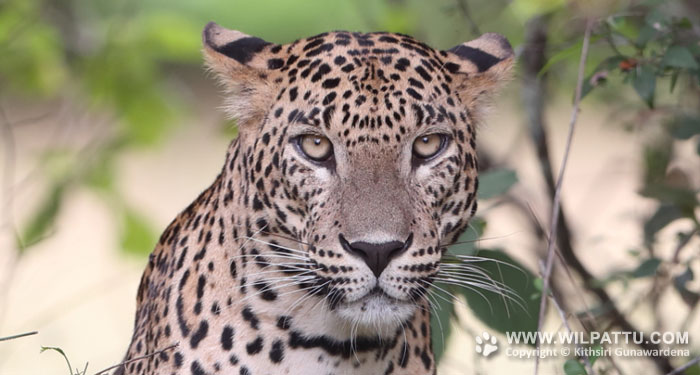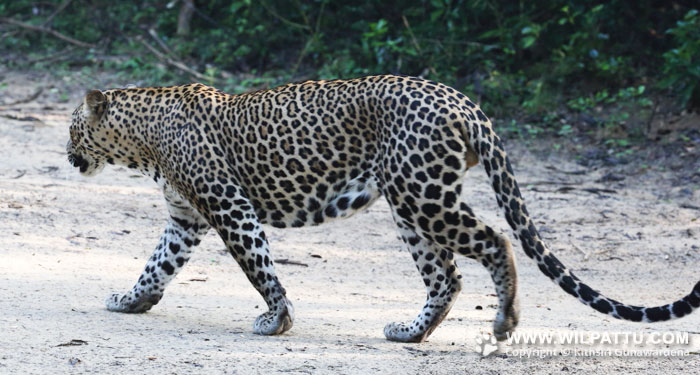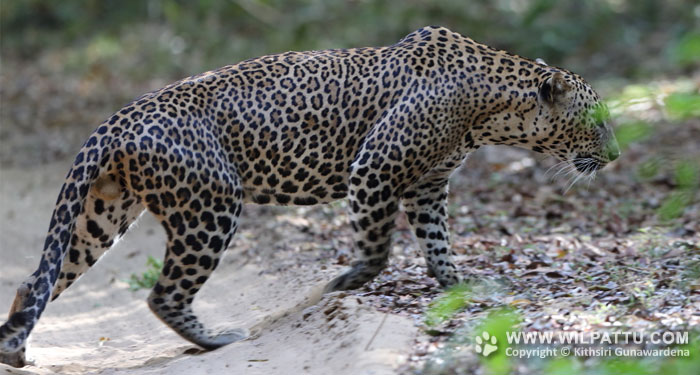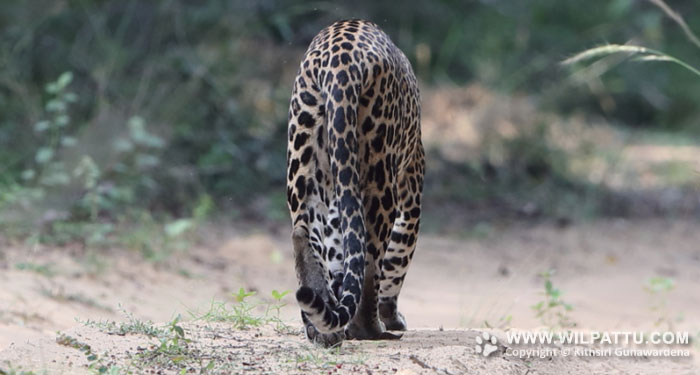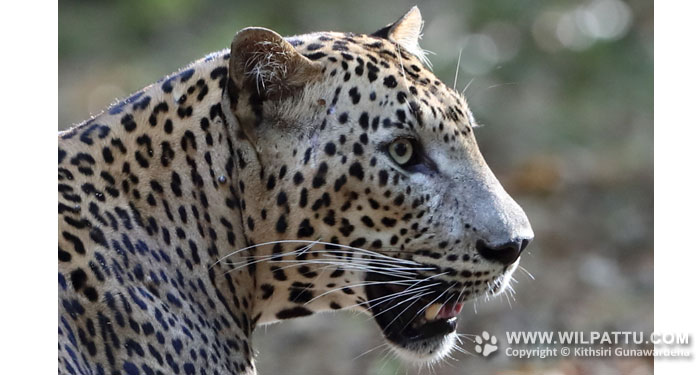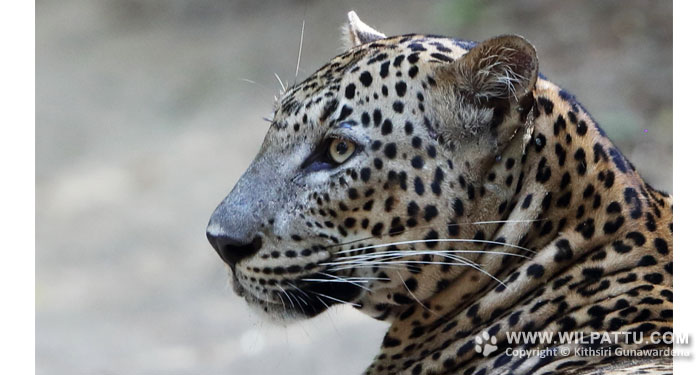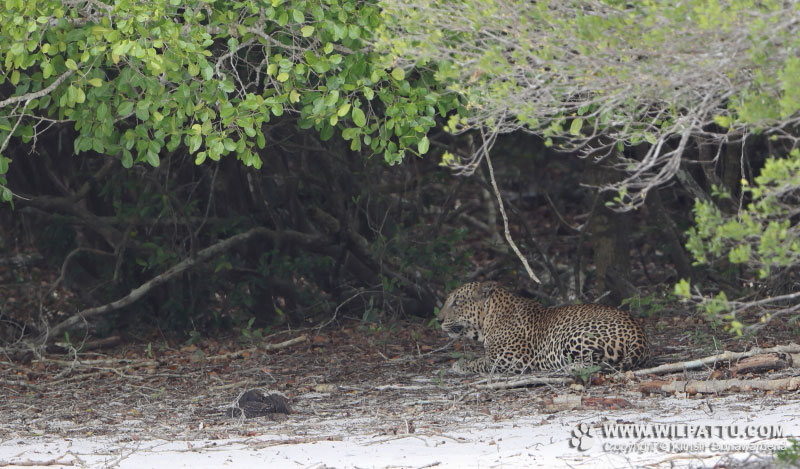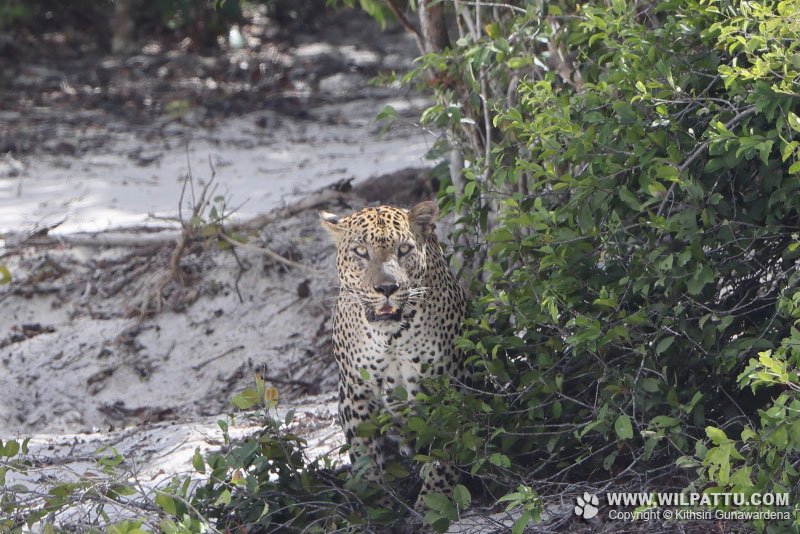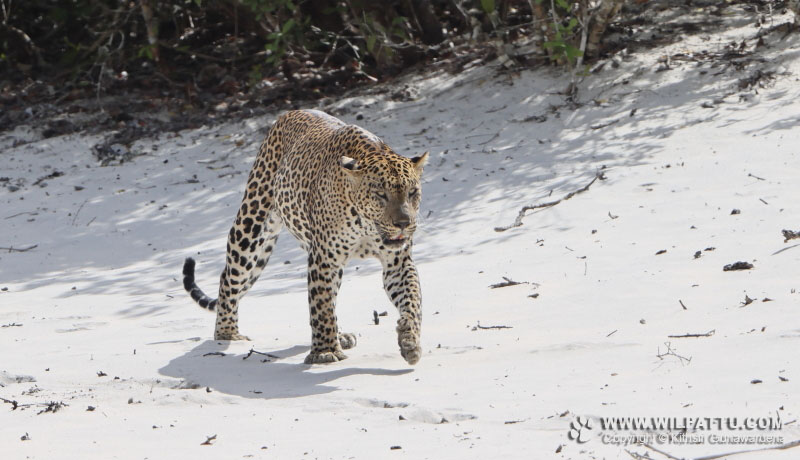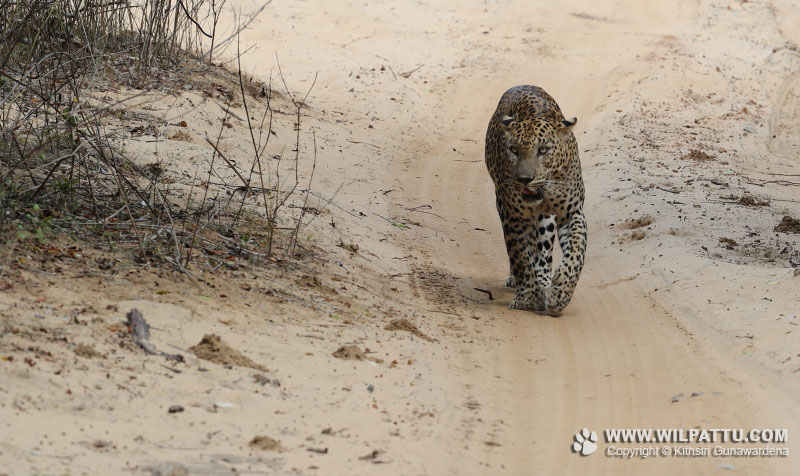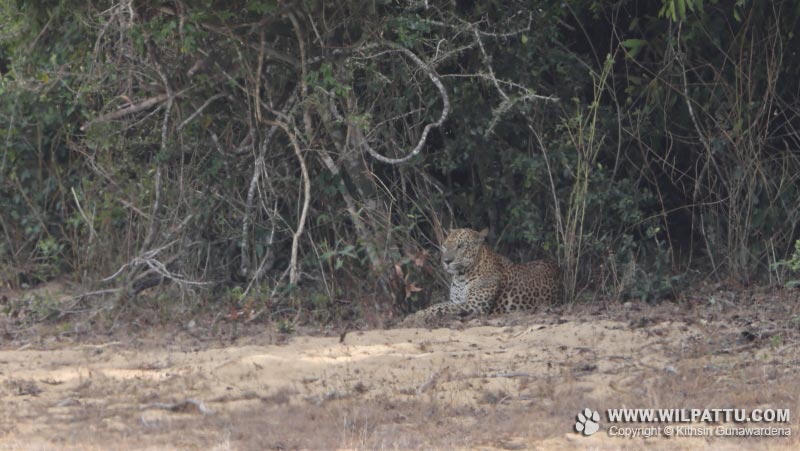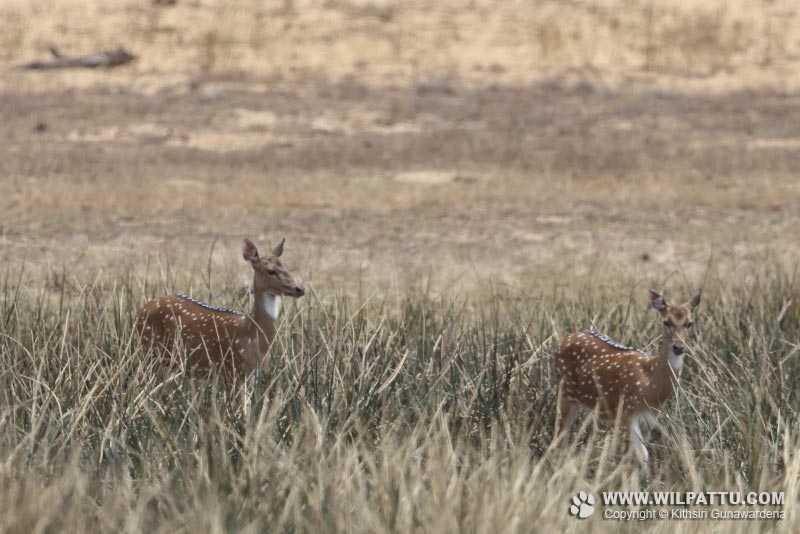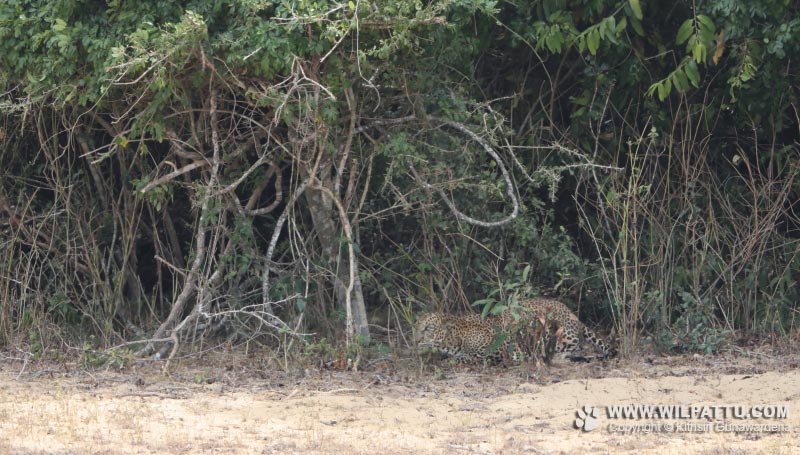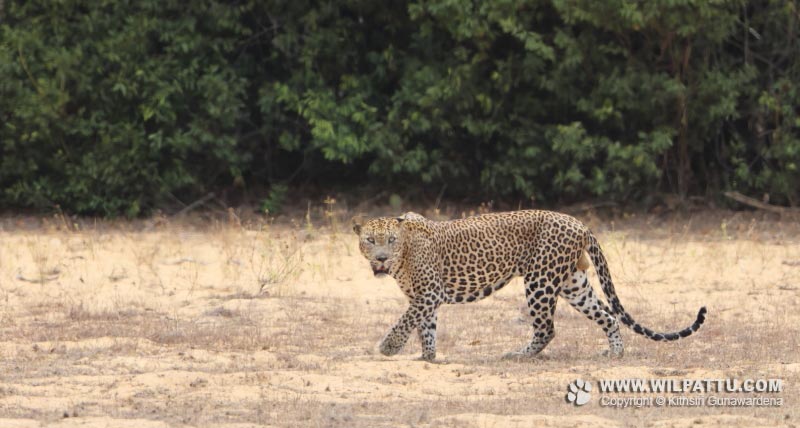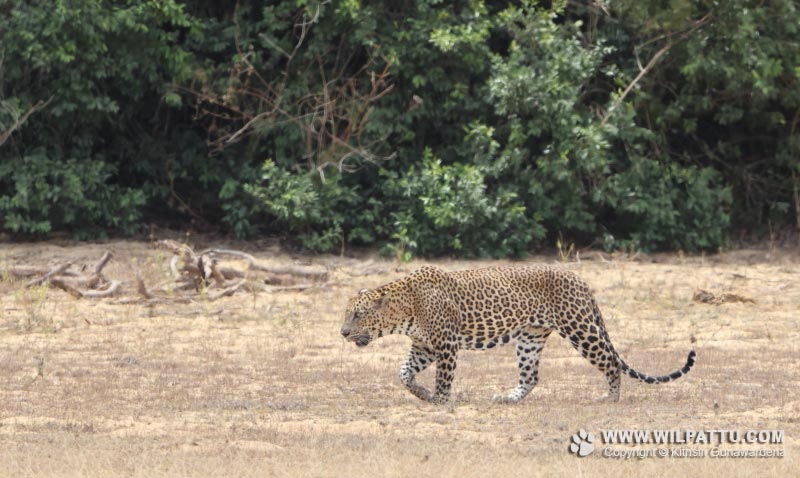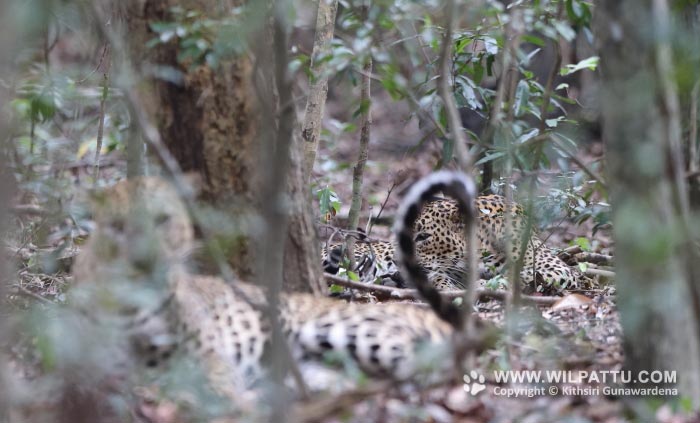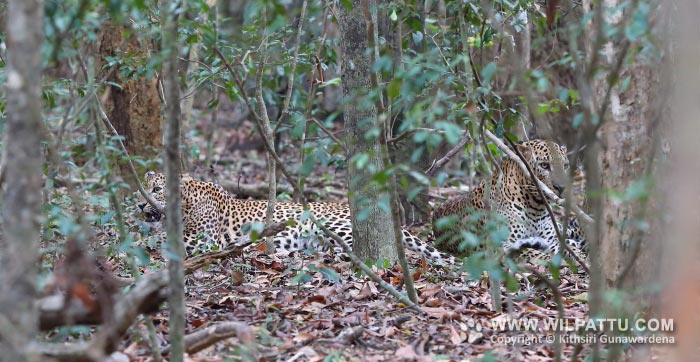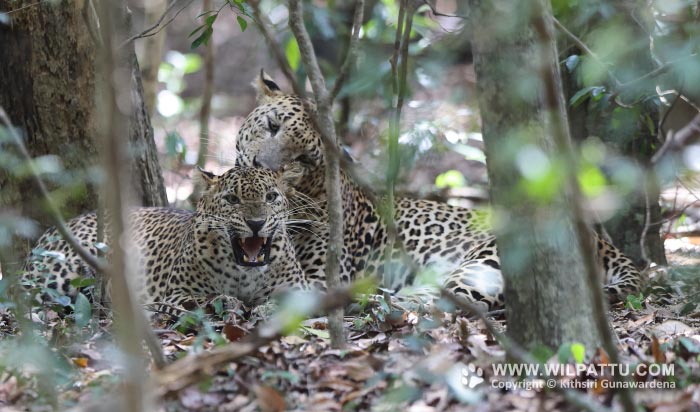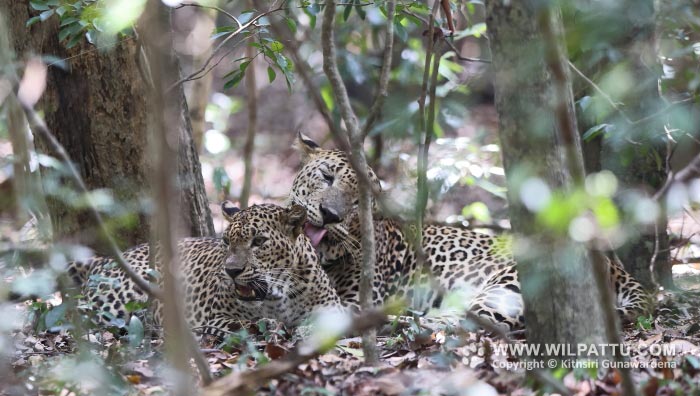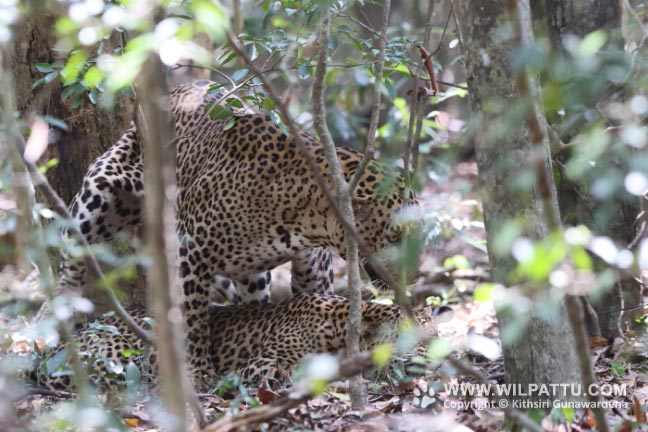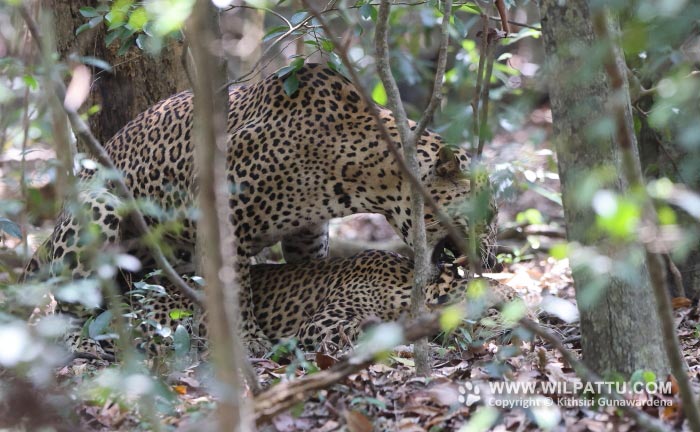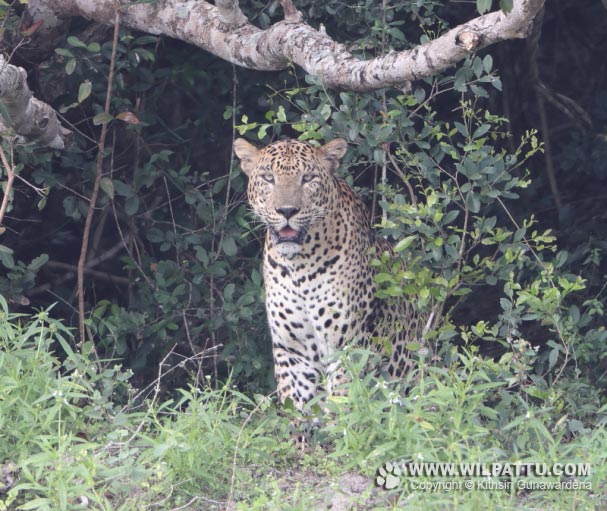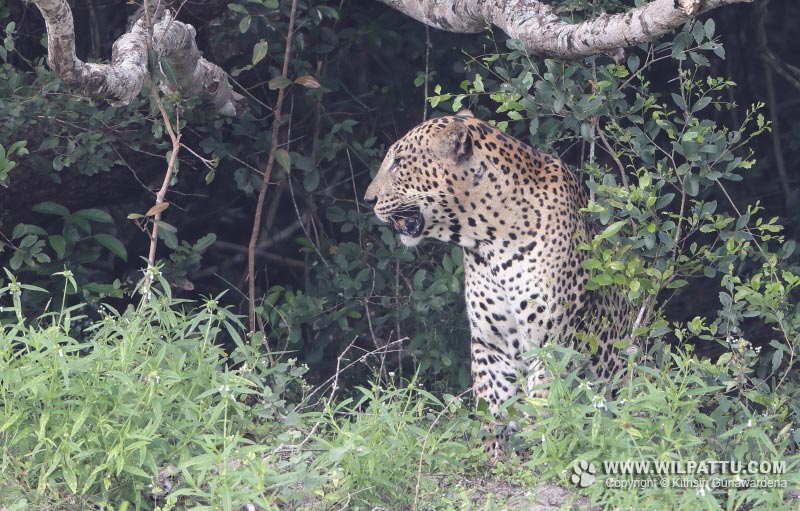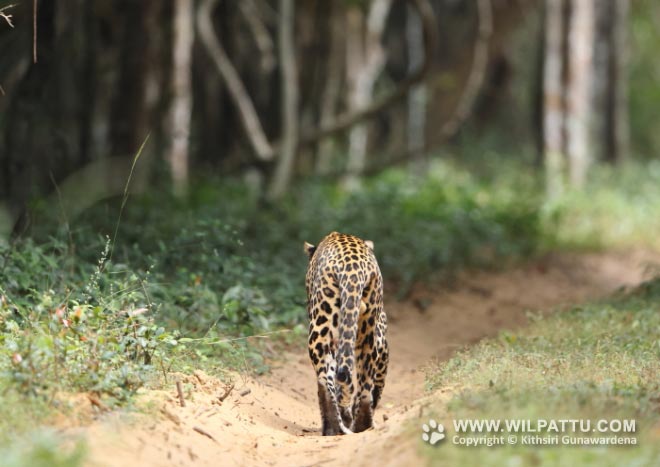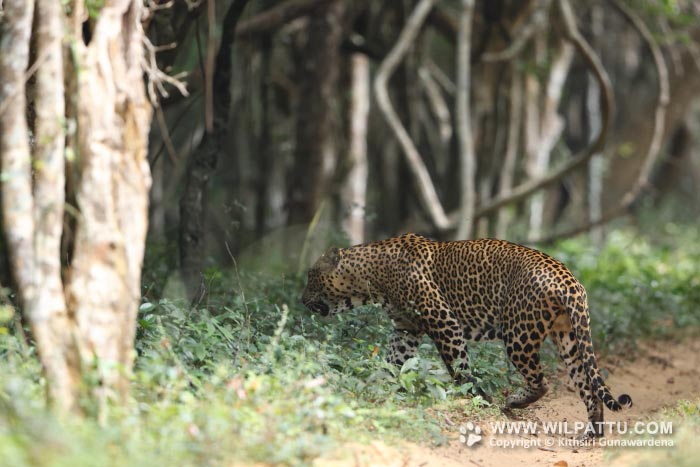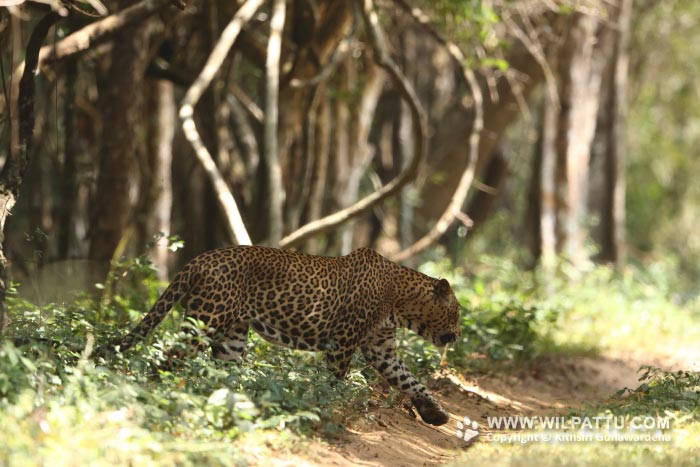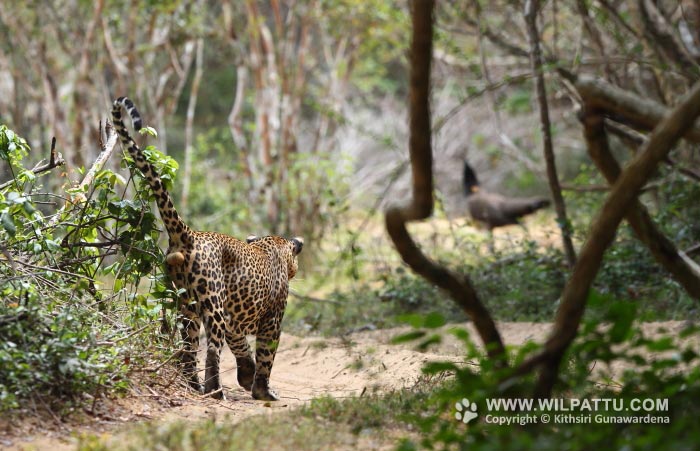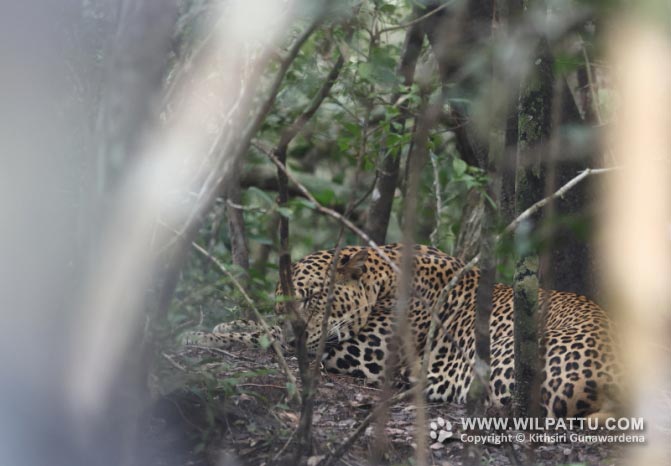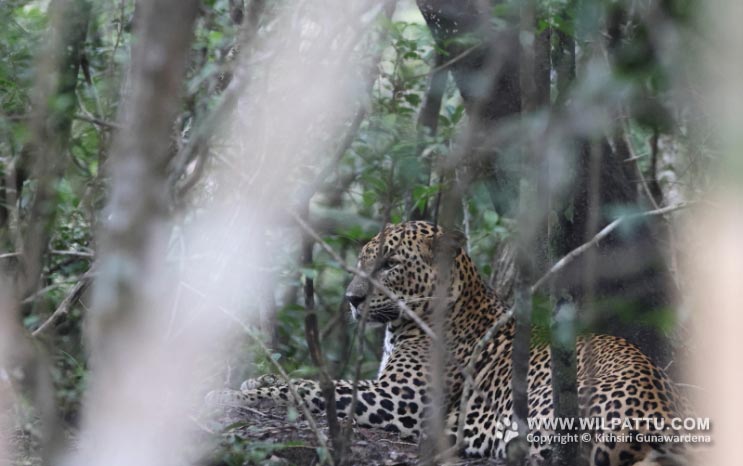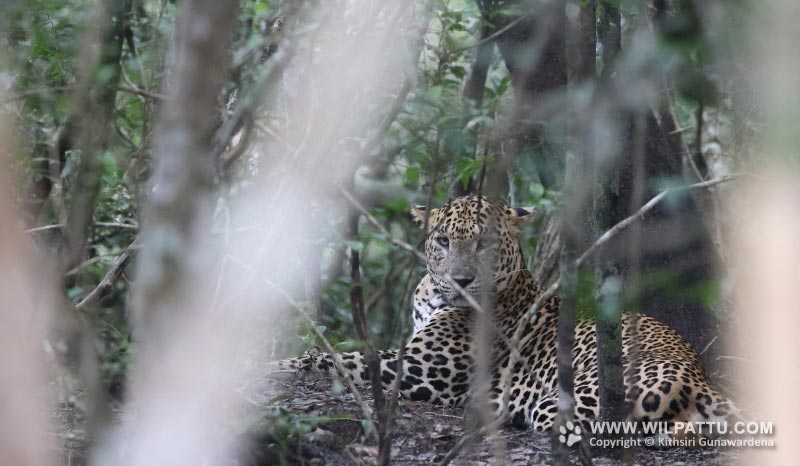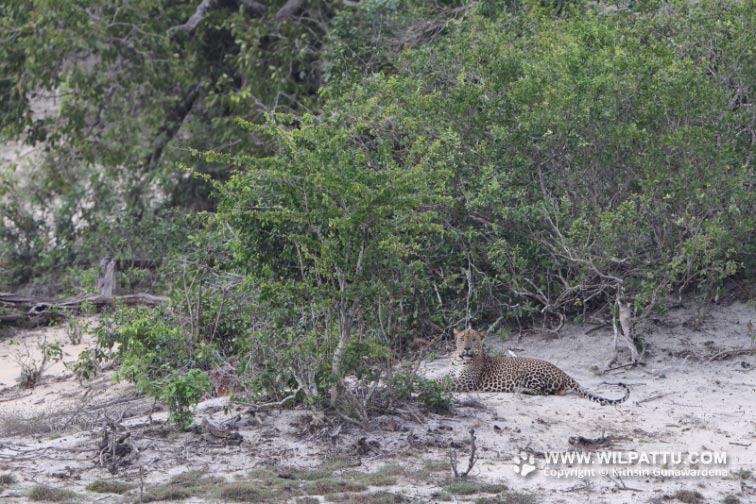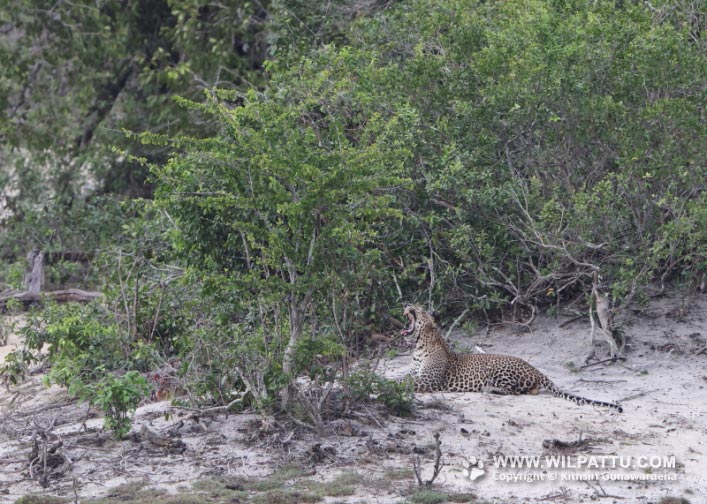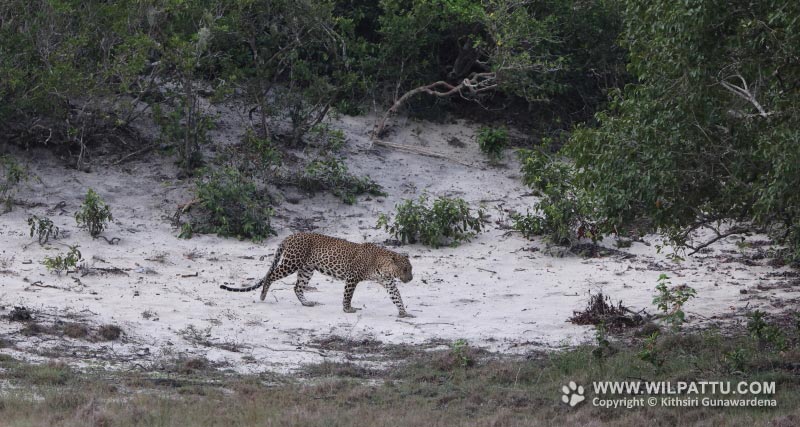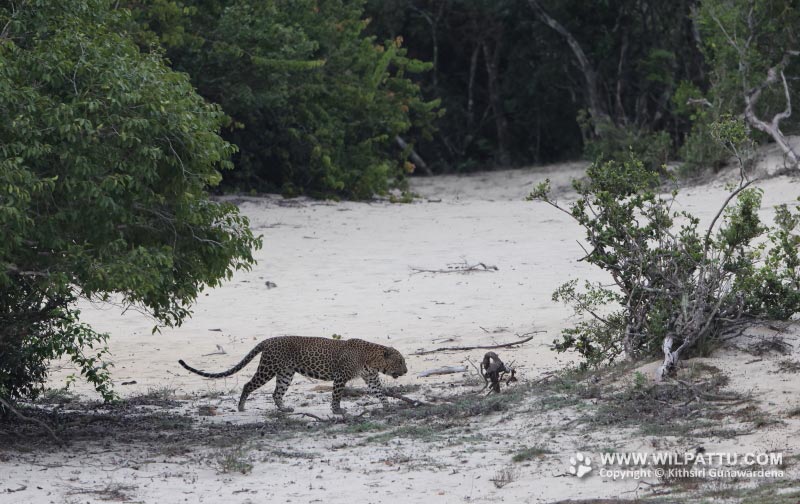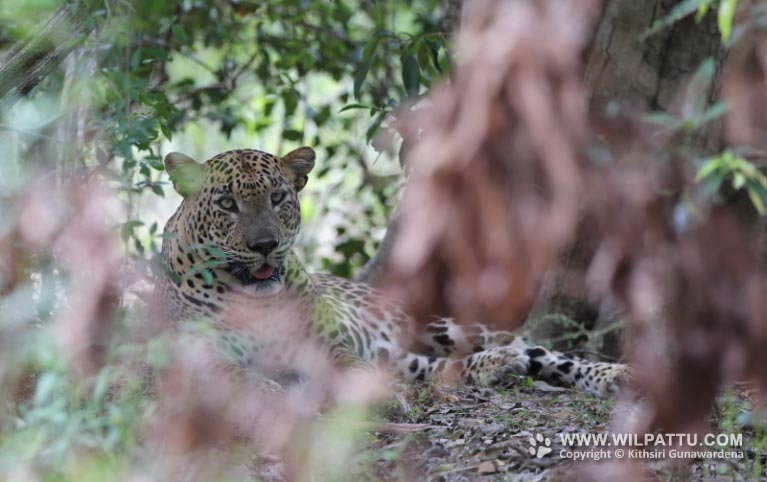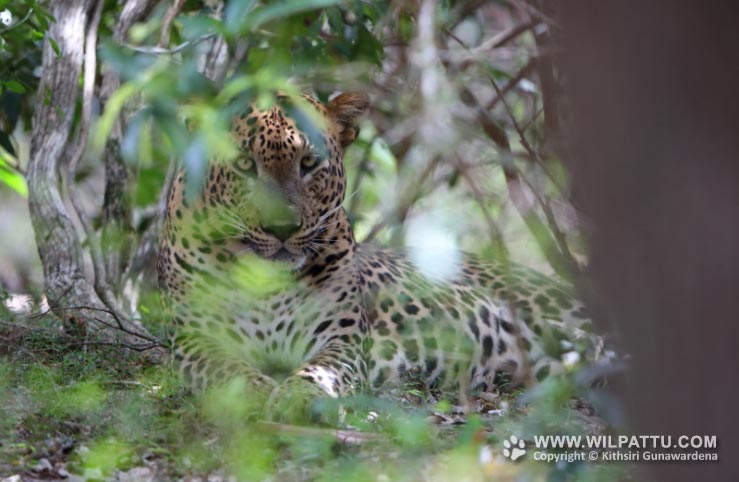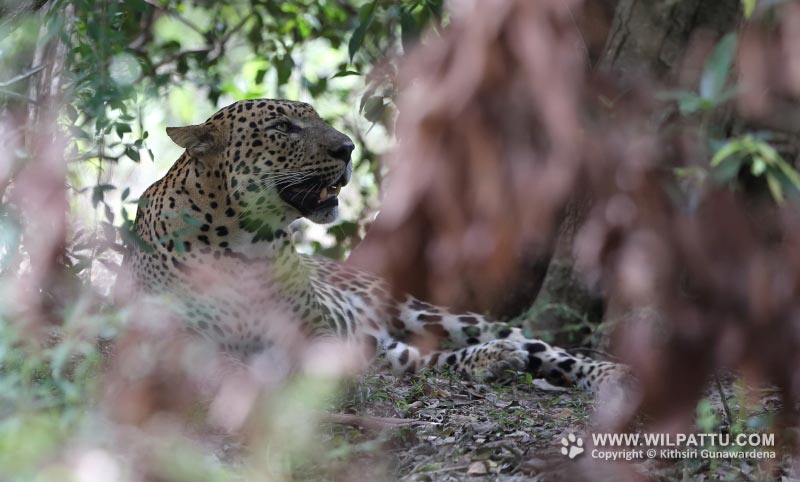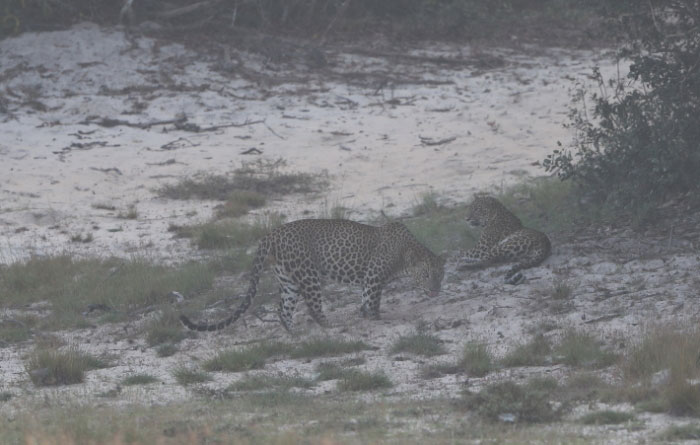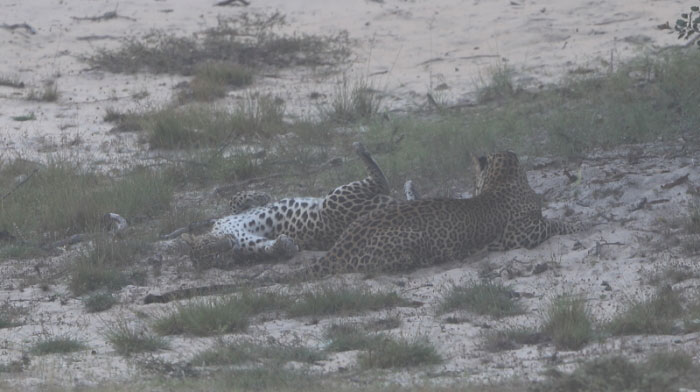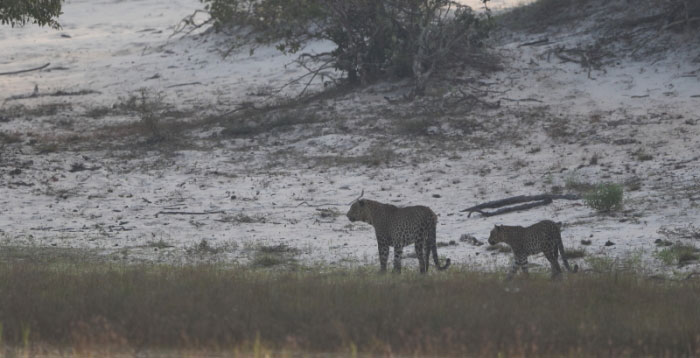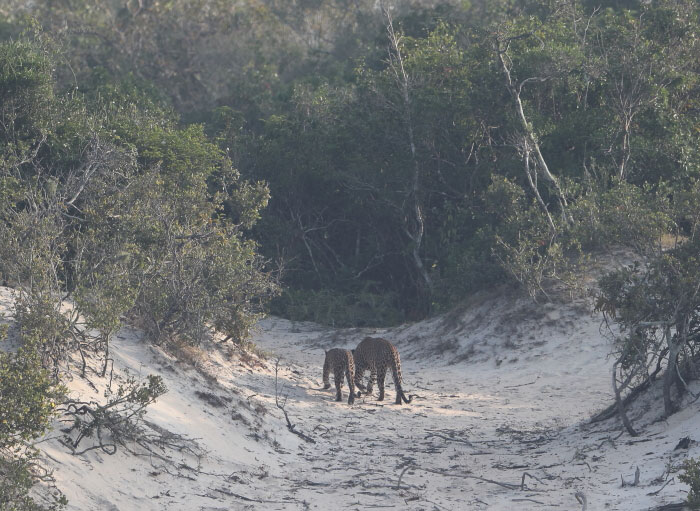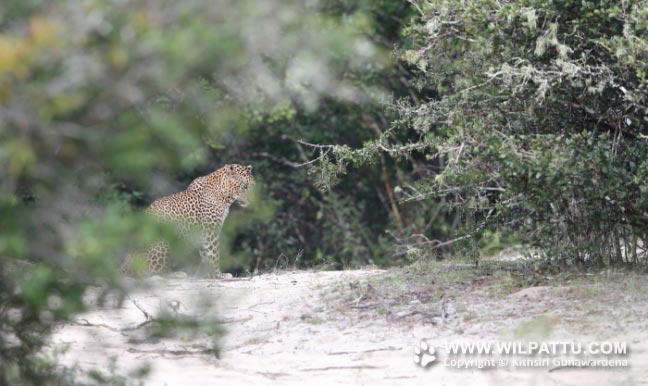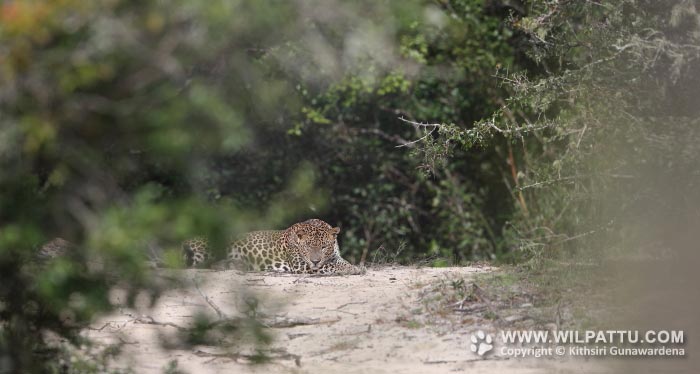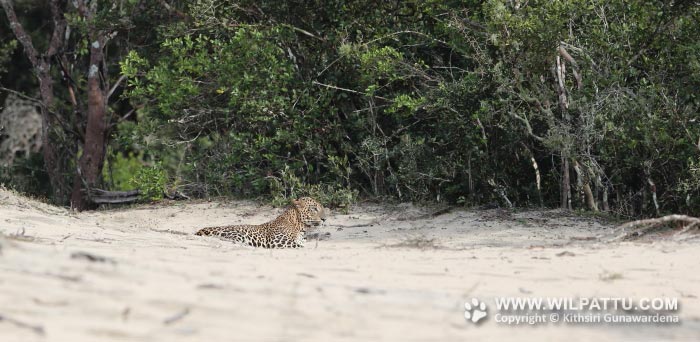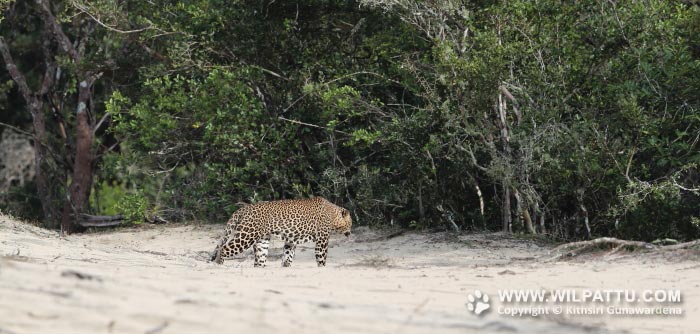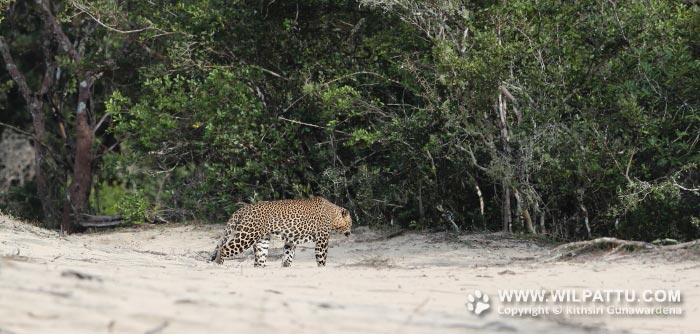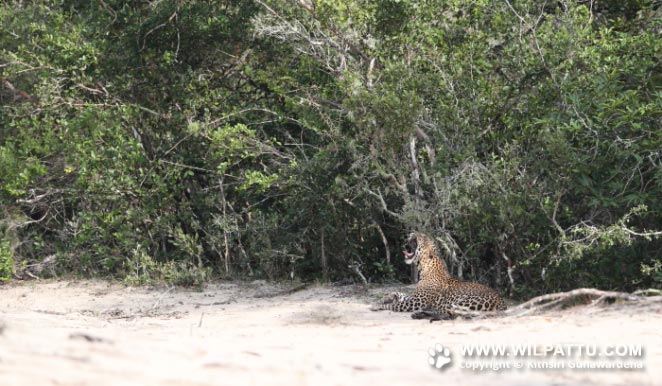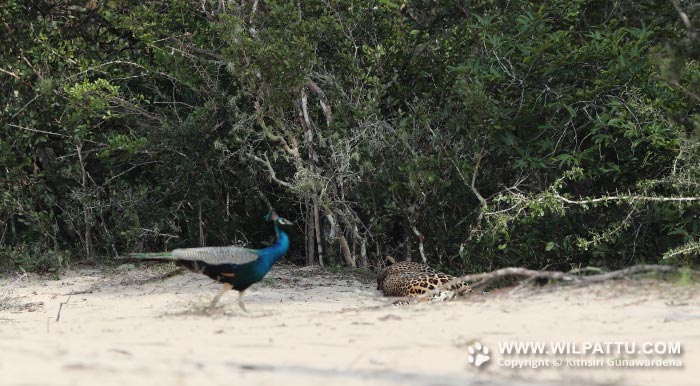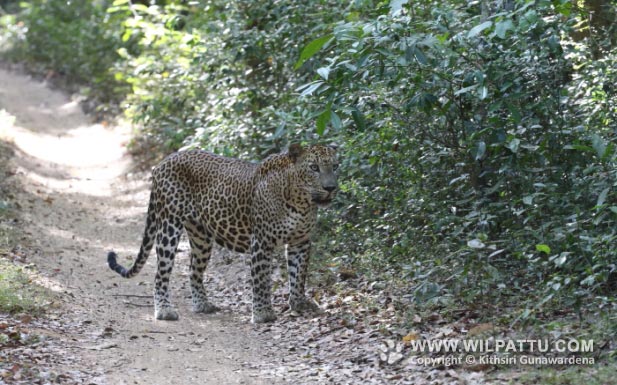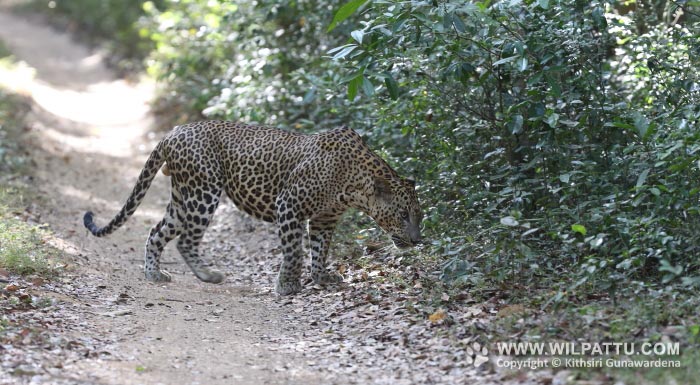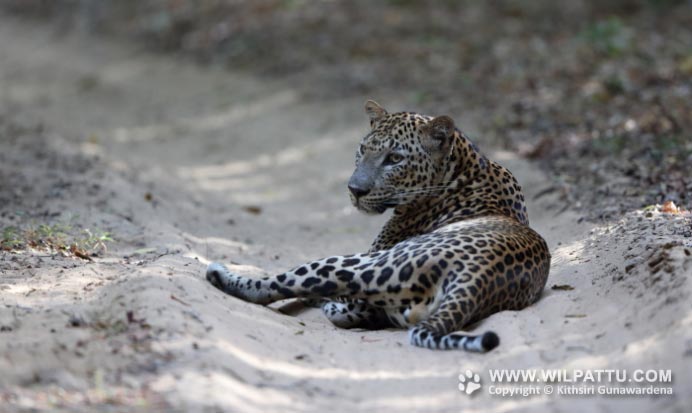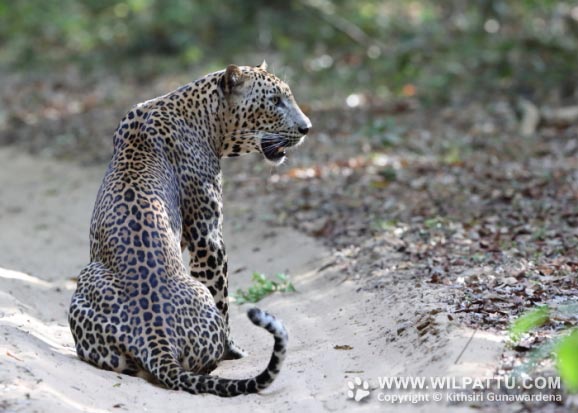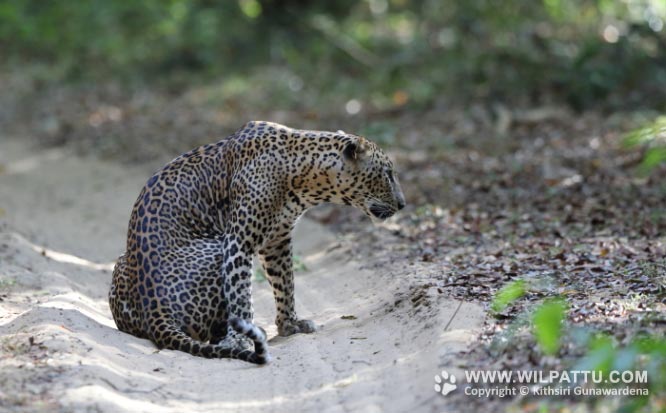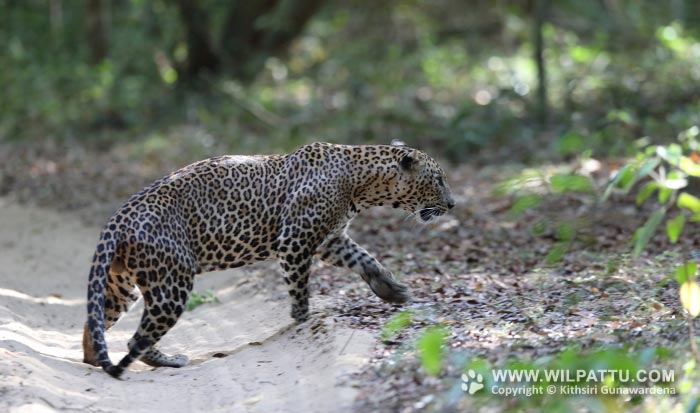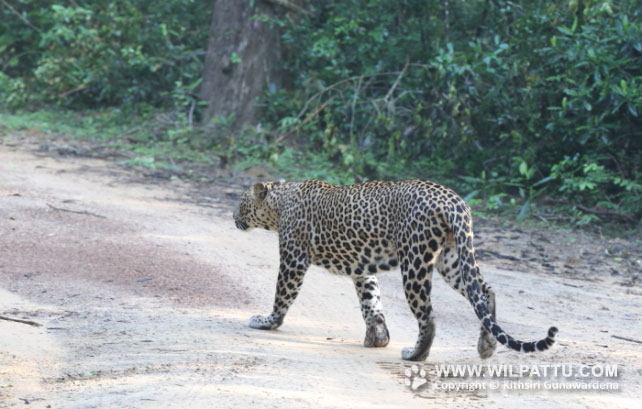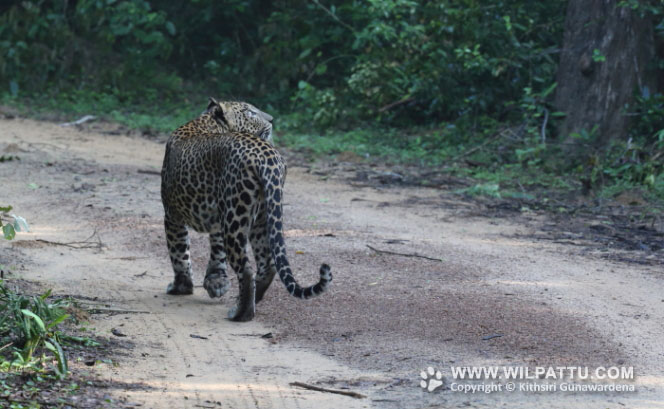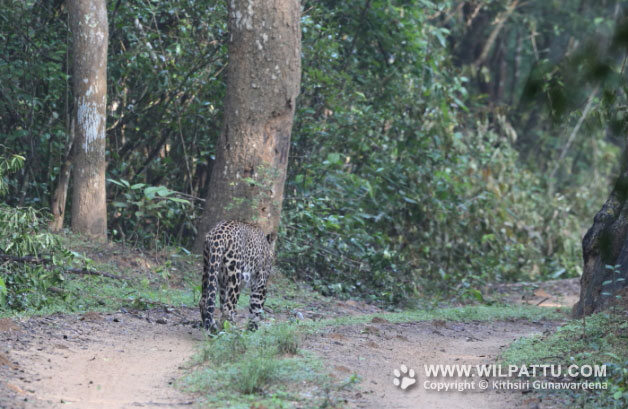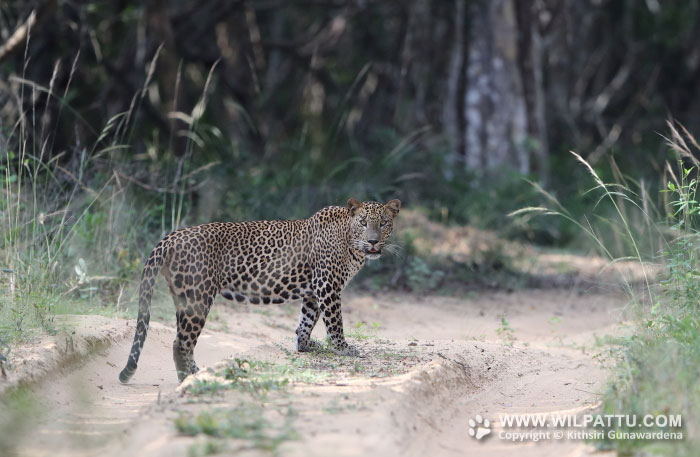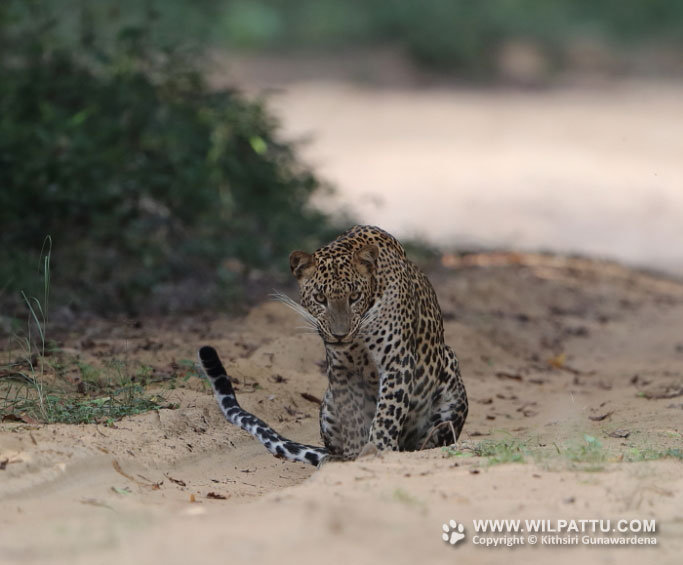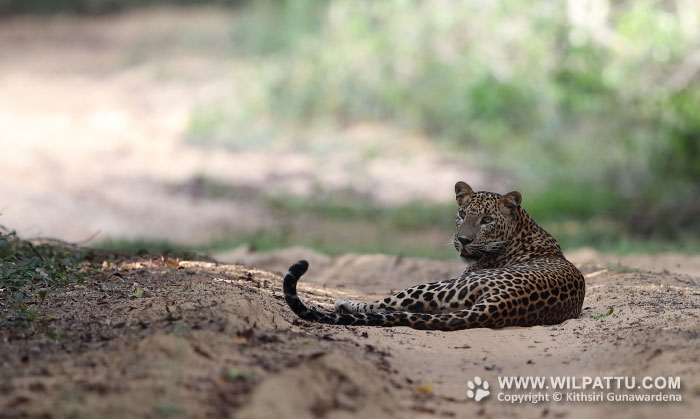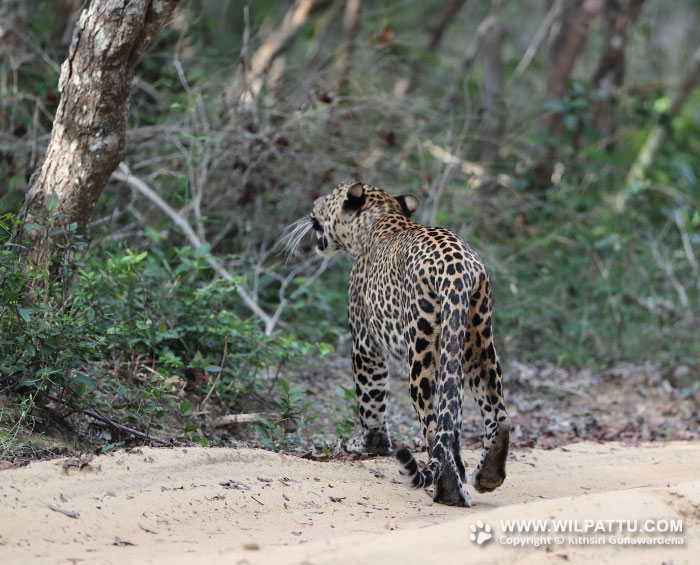-
14th August 2025 at 2.25pm one Leopard at Demata Wila. N 08.43917, E 080.00905
It was an adult male leopard sleeping at the edge of the water with its hind towards us. The vehicles had to drive in to the water to see the animal. We parked keeping about 40-50 meters from the animal to ensure he is not disturbed. After a few minutes he raised his head and started licking its stomach area. It was Nelum Wila Male 5 (NWMC 5) referred to as “Neluma” in Wilpattu. This is the current dominant male in the main Villu area of the park. During the last two months he had developed a bulge on its stomach, and many were quite concerned about its health as it started to increase in size. This growth did not appear to trouble the animal, and it looked in good health despite this growth. Considering this circumstance, it looked like an Lipoma, which is known to be a benign fatty tumor found under the skin that causes no pain. This bulge had disappeared but there was a small opening of its skin which the animal was licking. I was pleased to observe that the lipoma appears to have naturally drained off.
After a few minutes direct rays of the sun started to fall on the leopard, and he moved under the shade of a tree. Later, around 3.15pm with the arrival of more safari jeeps, many safari jeeps including me decided to drive off permitting the later arrival to have a close look. But it was sad to observe a few safari jeeps driving fast trough the water and moving too close to the animal. This unruly behaviour caused the animal to move quickly into the forest robbing many of the visitors of a good opportunity to enjoy a good leopard sighting.
-
23rd November 2024 at 4.43pm one leopard at Manik Wila. N 08.45600, E 079.98094
It was an adult male leopard that was lying inside the forest at the foot of a termite hill. It was concealed by the foliage. I managed to get a few images which enabled me to see the spot pattern on the left side of its face. It was Nelum Wila Male 5 (NWMC 5), the dominant male in the main villu area of the park.
-
22nd July 2024 at 3.41pm one leopard at Mahapatessa. N 08.43080, E 080.00391
It was the Nelum Wila Male 5 (NWMC 5), The dominant male leopard that was seen here in the morning. He was lying at the edge of the forest. I photographed the leopard and moved out permitting other safari jeeps that arrived after me also to drive down to the location where the leopard could be seen. Many other jeep drivers did the same.
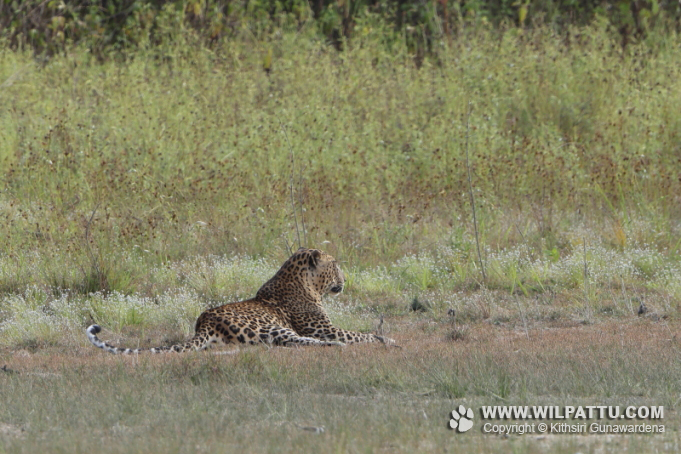
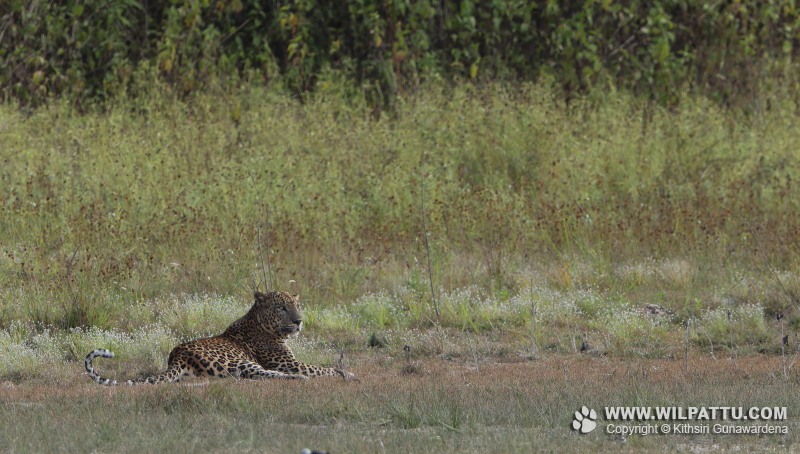
-
22nd July 2024 at 7.45am one Leopard on the road between Mahapatessa and Kumbuk Wila. N 08.42985, E 080.00423
The leopard was on the road with vehicles parked ahead and before him. He walked for a short distance in our direction but moved into the forest due to many vehicles blocking his path. It was again the Nelum Wila Male 5 (NWMC 5). I was not able to reverse as I usually do with an advancing leopard due to the others at the back remaining stationery. There after I drove down to Mahapatessa expecting the leopard to emerge at the forest edge and drink water. There were many jeeps parked but only the tail of the leopard was visible. Around 8.15am the leopard moved out briefly but walked back into the forest.
-
21st July 2024 at 12.15pm one leopard on the road between Kokkare Villu and Kuruttupandi Villu. N 08.43073, E 079.98315
There were vehicles parked beyond and before the leopard. After a few minutes he walked in our direction and moved into the forest. It was Nelum Wila Male 5 (NWMC 5), popularly referred to as “Neluma” by the safari jeep drivers. This is the dominant leopard in the main villu area of the park and the same leopard that was photographed at Kumutu Villu yesterday.
-
20th July 2024 at 3.42pm one leopard at Kumutu Villu. N 08.45907, E 079.97392
It was a mature male and was lying across the water body at the edge of the forest. He was observing a herd of 10 Buffalo at the opposite end. There were many safari jeeps that had arrived at Kumutu Wila. After having got a few images, I decided to leave to reach the park entrance by 6.00pm. Later upon examination of the spot pattern I noted that it was Nelum Wila Male 5 (NWMC 5).
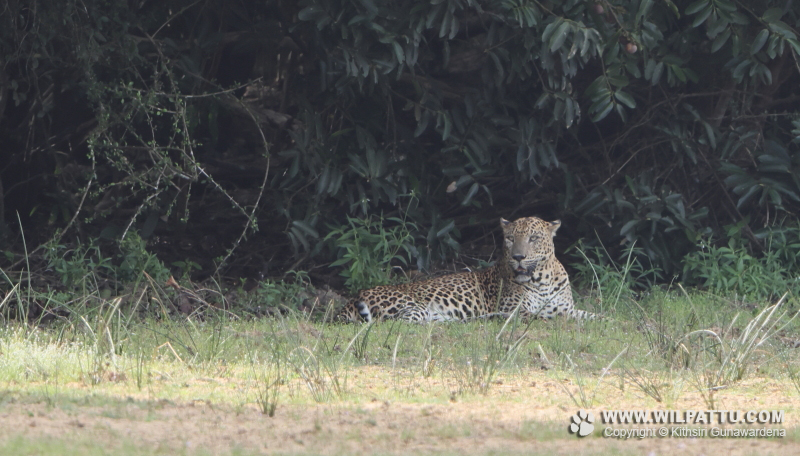
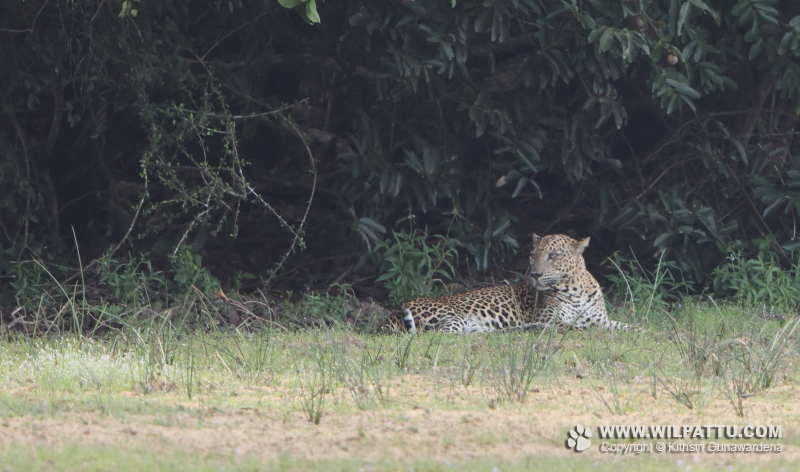
-
30th June 2024 at 9.36am one leopard at Kumutu Wila. N 08.45958, E 079.97339
I drove down to Kumutu Wila to check on the young leopard I observed yesterday and spotted him at the same location with the help of my binoculars. I was quite certain now that this young male, Kumbuk Wila Male 2 (KWMC 2) had made a kill which is lying inside the forest.
10.36am the young leopard started to look intently in the direction of the forest and moved hurriedly into the forest. As he did, the forest reverberated with the loud growls of two leopards, and one ran out into the open with a partly eaten leg of a Wild Boar in its mouth. It was our young leopard, the Kumbuk Wila Male 2. He then crouched down holding on to the chunk of meat and continued to growl while looking in the direction of the forest. In less than a minute a big male leopard walked into the open from where the young leopard moved out, casually marked the bushes without looking in the direction of the younger male. He did not show any aggression and walked away from the young leopard into the forest. KWMC 2 watched every move of the older leopard while continuing to growl with his head lowered to the ground. Thereafter he carried the Wild Boar leg and walked back into the forest. Upon examination of the spot pattern, I noted that the big male was Nelum Wila Male 5 (NWMC 5), the dominant male in the core area of the park. I have seen this big male attacking and casing away bigger male leopards and claiming their kills. During the dry months when this water body was a small pool of mud this male drove a younger male in to the mud at this very location. In my opinion the reason for this tolerance and nonaggressive behaviour by this usually very aggressive male was his relationship to the younger male. The mother of this young male, Kumbuk Wila Female 2 (KWFC 2) popularly referred to as Cleopatra, is one of the females whose territory is well within the territory of this dominant male. There are many records of them mating regularly. Thus, even though female leopards are known to mate with other males while the dominant male is not around, it is very likely that he is the father of this young male and even if not, he believes it to be his offspring.
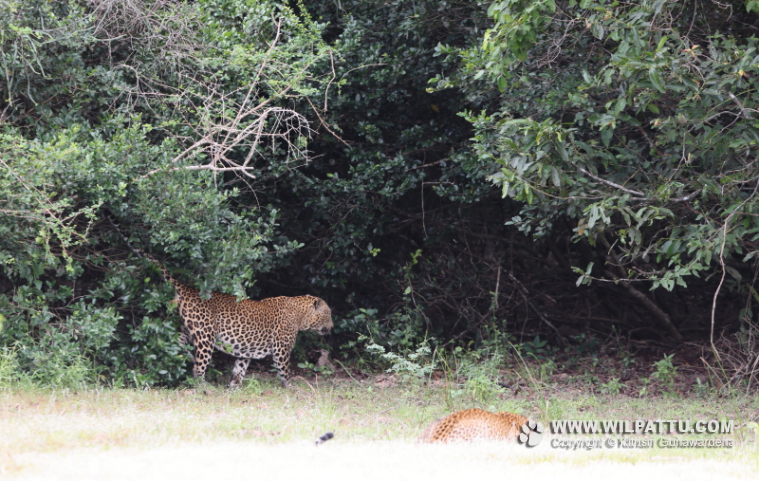
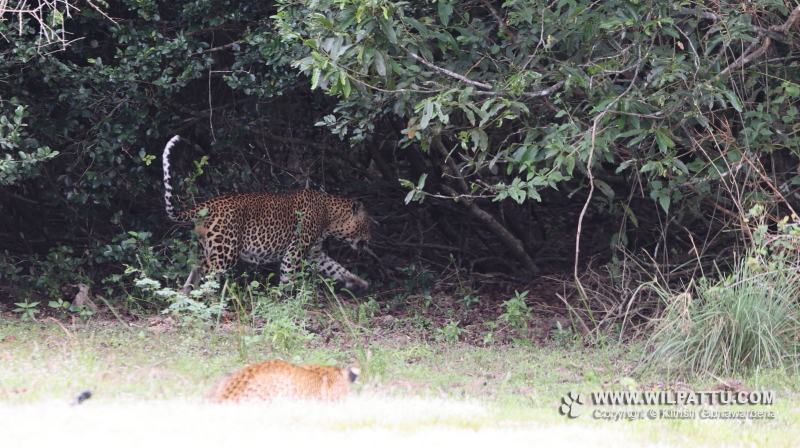
-
29th June 2024 at 4.49pm one leopard on Kokkare villu upper road. N 08.41205, E 079.98774
I observed safari Jeep driver Jeevan Nishantha reversing his vehicle with a big male leopard walking in our direction. I angled the vehicle and managed to get a few images of the advancing leopard. It was Nelum Wila Male 5 (NWMC 5), the dominant male in the core area of the park. I was not able to keep pace at the speed the leopard advanced and had to wait until he walked pass my vehicle. Thereafter he moved back on to the road behind my vehicle and continued his walk. The injury he had on the right leg had healed well. I left to reach the park entrance on time.
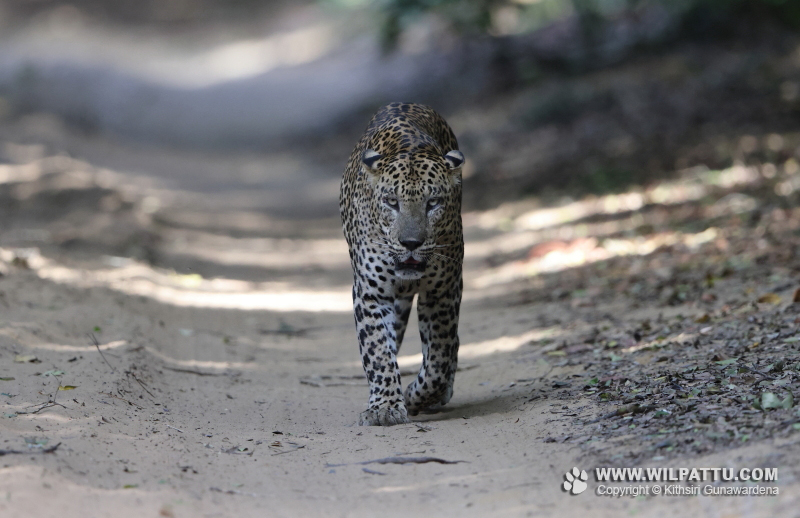
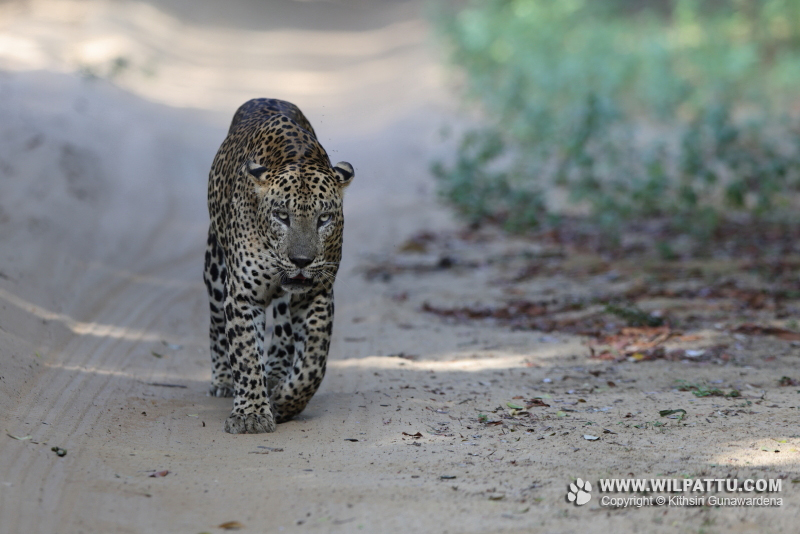
-
22nd April 2024 at 7.41am one leopard on Kokkare Villu upper road. N 08.42301, E
079.98370
It was a big male leopard and was walking ahead of the vehicle. I noticed an injury on its right hind leg. He walked on the road for a short distance and moved down into the bush towards the villu. I was able to identify the leopard without much difficulty as the Nelum Wila Male 5 (NWMC 5) the dominant male in this area of the park. He was apparently attacked by a sounder of wild boar on the 14th or 15th of April 2024 close to Manik Wila bungalow where he had susutained this injury. The injury did not appear to bother him much as he had killed an adult Wild Boar at this locality on the 16th and had dragged the carcuss into the thicket towards the villu. It is likely that he was feeding on the remains. The injury was showing signs of healing well. Despite waiting at this location for about 30-40 minutes the leopard did not come back to the road, and I decided to drive down to Kuruttupandi Villu to give him some time. I was pleased to have got an image of its injury so that I can study its spot pattern before and after recovery.
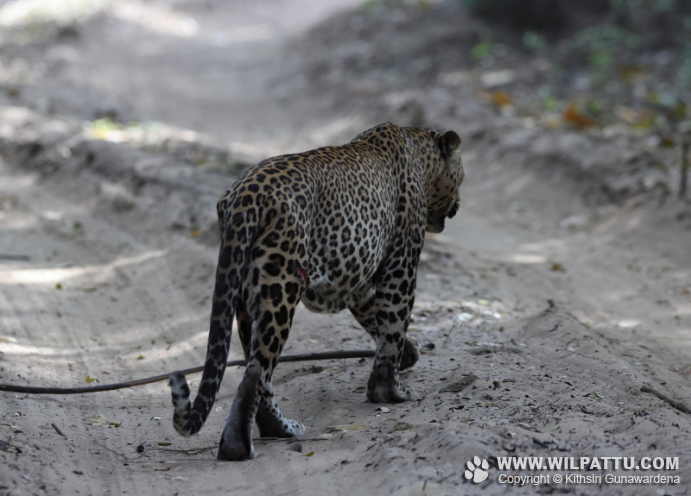
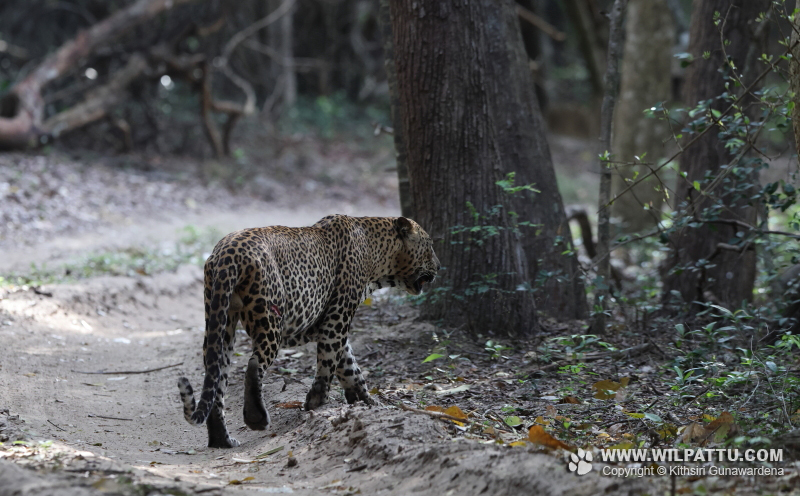
-
22nd April 2024 at 9.08am upon my return I observed a few vehicles parked and
Nelum Wila Male 5 (NWMC 5) was lying down in the forest less than 15 feet from
the road to Kokkare Villu from Kuruttupandi Villu. N 08.42589, E 079.98325
With many other safari jeeps arriving to get a glimpse of the leopard I drove off permitting
others also to have a view of this impressive dominant male.
-
3rd October 2023 at 9.20am one Leopard at Kuruttupandi Villu. N 08.43542, E 079.98268
The adult male leopard was sleeping under the shade of a Madan tree. Within about few minutes a Wild Boar was seen in the distance and the leopard raised its head and was alerted. Though the leopard observed the wild boar for some time he did not make any attempt to attack. Once the swine moved away the cat started to lick its paws, yawned, and walked in the direction of the road. He walked for a short distance on the road and moved into the forest in the direction of the upper road.
-
I drove on to the upper road and spotted the leopard on a Banyan Tree. Around 10.16am with the arrival of a few more vehicles the leopard climbed down from the tree and disappeared into the forest. This is Nelum Wila Male 5 (NWMC 5) on my site. He is currently the dominant male in the core area of the park.
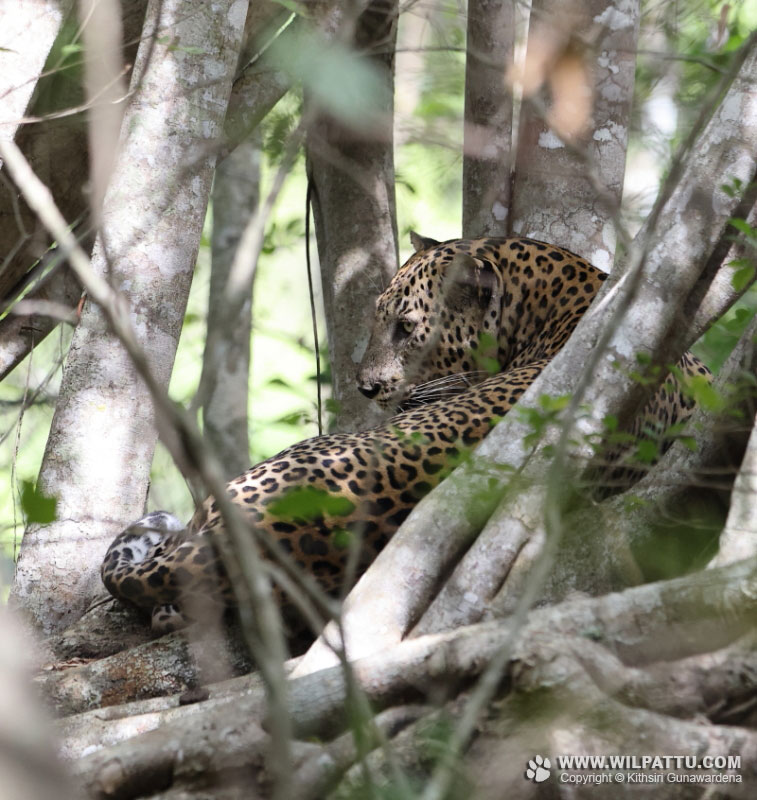

-
31st July 2023 at 10.27am one Leopard at Kumutu Villu. N 08.45924, E 079.97369
The adult male leopard lying at the edge of the forest across the villu. It was Nelum Wila Male 5 (NWMC 5), the dominant male in the main villu area of the park. This is my first record of this leopard at this location. I was happy to see him expanding his territory. Around 11.15am a herd of 7 Spotted Deer walked cautiously up to the edge of the water and drank. The leopard was alerted by the presence of deer but made no attempt to attack. He watched them drink and walk back to the forest. The deer did not detect the well camouflaged leopard. At 12.44pm the leopard broke cover and walked into the forest in the direction of Kanjuran. The heavy heat haze resulted in the images being of a much less quality.
-
1st July 2023 at 2.45pm 3 leopards at the Sambhur kill at Kudapatessa. N 08.43159, E 079.99229
I observed a dead Sambhur antler at Kudapatessa in the morning during the last day of my previous visit to the park on the 27th of June 2023. The jeep drivers who occupied the park bungalows confirmed that they had not observed this carcass the previous evening. There were no leopard sightings associated with this carcass or the entire day.
I received information of leopard sightings at this kill from the 28th and was thrilled to have spotted two leopards, and adult male and a younger male, sleeping under the shade of a tree at the edge of the forest. After some time, a third female leopard walked up to the adult male and was enticing him to mate with her by engaging in typical premating behaviour by rubbing her body against him and sitting on his body ect. The big male mounted her and mated with her once. Thereafter she moved back in to the jungle. Around 4.15pm The younger male walked down the sand rimmed edge of the villu, and the female followed him up to the kill. But while the male started to feed on the kill the female turned back and walked back to the big male. After feeding for about 10 minutes the younger male walked back to where the big male and lied down beside him. There was no aggression expressed by the big male or the female towards the younger male.
Later upon examining the spot patterns of these leopards I was happy to note that the big male was Nelum Wila Male 5 (NWMC 5), the dominant male of the area. The female is Manikrala Uraniya Female 1 (MRUF 1), who is referred to as Kuruttupandi female by the jeep drivers and who successfully raised one female cub with her first litter. The younger male is Kumbuk Wila Male 1 (KWMC 1), one of the first litter male cubs of Kumbuk Wila Female 1 (KWFC 1), popularly known as Cleopatra. It is quite likely that this big male is the father of this cub.
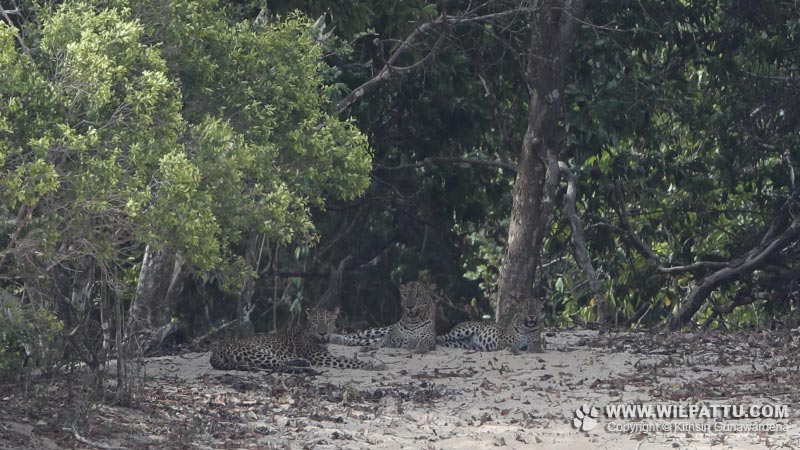
-
1st April 2023 at 9.30am – 2.47pm two leopards at Eriyakkulampooval. N 08.43872, E 080.00075
It was a male and a female engaged in copulation. Such a pair is referred to by the jeep drivers and guides as a “mating couple”. The leopards had been in the open and mating but had moved into the forest. Many jeeps were parked where they could be heard growling. I parked at a distance since there was no view or possibility of photography. Around 11 am the male leopard moved in the direction of the road leading to Manikrala Uraniya followed by the female. The jeeps that had gathered rushed on to the narrow road. As expected by mid-day most safari jeeps left, I waited until 12.55pm and drove up on to the location where the leopards could be seen. There were only two jeeps left, and they were kind enough to move their vehicles and give me space. I parked the vehicle where the leopards could be seen through the foliage. It was the dominant male in the area Nelum Wila male 5 (NWMC 5) referred to as Neluma and Kumbuk Wila Female 2 (KWFC 2) popularly referred to as Cleopatra. They were lying on the forest floor about 30 feet off the roadside by side and flicked their tails regularly. I was quite pleased to observe the mating behaviour of these cats at such close range. The female initiates the act of mating by walking around the sleeping male with a low growl and caressing him with her body and tail. Then she lowers herself to the floor in front of the male, inviting him to mate. The male does not mount her immediately but shows affection by licking the back of her neck. After few such attempts the male responds by mounting her and mating. Between 12.55pm to 2.47pm they mated every 15 to 20 minutes. Each act of mating lasts for about a minute and ends with loud growls where the female turns and attempts to hit the male with her paw. He jumps off her to avoid being hit with a loud growl. The estrous cycle of a leopardess is said to last for about one and a half months, and she will remain in heat for 7 to12 days every 2 – 3 months. If she conceives the gestation period is 3 to 3 and a half months. If a cub dies a female will come in to heat in two weeks. I received reports and images of this female (KWFC 2) mating with this male (NWMC 5) on 29th and 30th December at Kokkare Villu and Demata Wila respectively. Thereafter on the 4th of February she was seen mating with another male, Nelum Wila Male 4 (NWMC 4) at Walas Wala. Therefore, despite mating with this dominant male in December she had not conceived and had come in to heat again in 35 days. Evidently, she had not conceived for the second time in February as 55 days after she mated with NWMC 4 she is now mating again with the same dominant male. I have no information whether she also mated with any other male during this period. If this copulation is successful, she should be having her second litter by June this year.
-
7th March 2023 at 10.15am We were informed of a leopard on a Madan Tree at Kokkare Villu and decided to go check it out. While on the way at the Thimbiri wila end of Borupan Wila spotted another mature male leopard seated at the edge of the forest. N 08.42697, E 080.02013
It was Nelum Wila Male 5 (NWMC 5) popularly referred to as “Neluma” by the jeep drivers. Having taken a few images, we decided to quickly check the leopard at Kokkare Villu and return as I expected this leopard to move in the direction of the kill.
-
6th March 2023 at 4.55pm another leopard on Kokkare Villu upper road N 08.41255, E 079.98985
It was a big male leopard and was sleeping about 20 feet from the edge of the road. I managed to get a few images to identify the leopard and left as we had to reach the park entrance by 6.15pm. Later upon examination of the spot pattern I noted that it is the dominant male in the core are of the park the Nelum Wila Male 5 (NWMC 5).
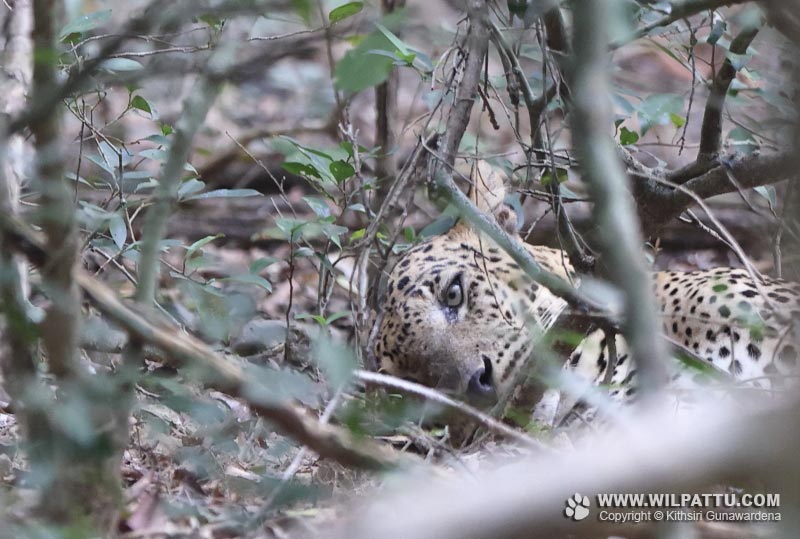
-
8th January 2023 at 4.15pm one leopard between Mahapatessa and Thimbiri Wila. N 08.42938, E 080.00560
The big male leopard was lying on the road with vehicles parked about 30 meters ahead of him and behind him. Safari jeep driver Sandun was polite enough to move his vehicle which permitted me to get some images despite there being two other vehicles ahead of me. The leopard was Nelum Wila Male 5 (NWMC 5), the dominant big male leopard occupying the main villu area of the park and popularly referred to by the jeep drives as “Neluma”. After a few yarns the leopard moved into the forest.
-
11th December 2022 at 11.45am an adult male leopard on the Kumbuk Wila upper road. N 08.41842, E 080.00190
It was Nelum Wila Male 5 (NWMC 5), the big male referred to as “Neluma or Nelum Wila big male” by the jeep drivers and guides. I was quite pleased as this is one of the biggest male leopards in the park. He was seated by the side of the road close to Madangaha Wala and vomited before walking towards Kumbuk Wila. I have, on several occasions, observed leopards vomitting by continuous movements of pushing their stomachs upwards and their bodies forwards until it ends up with the cat throwing up. Unlike with humans where, vomiting is associated with sickness, it is a regular activity for leopards and other species of cats. It’s a mechanism by which they dispose of material they have difficulty in digesting, or which gives them discomfort. Cats accumulate large amounts of fur in their stomachs due to licking themselves clean and from their prey which often remain undigested. Thus, they regularly eat grass that has emetic qualities and engage in vomiting to get rid of such material to cleanse their stomachs.

-
As usual the “Nelum Wila big Male” was quite relaxed and walked with intermittent rests and a short spell of sleeping. Upon reaching a large old Madan tree with a trunk horizontal to the ground he climbed on to the trunk and engaged in scraping the bark with his paws. He was so close to the vehicle I had to use the 100mm macro lens to capture him in the act of scraping. Other than spraying urine and depositing scat, scratching the surface of trees, and leaving scrape marks is a method by which leopards to leave their scent and sharpen/clean their claws. While lying on the road and licking his paws he was alerted by a small herd of Spotted Deer and looked in their direction but continued to walk on the road. On each occasion he decides to lie down I would bring my vehicle to a hault and reverse when he resumes his walk, keeping an adequate distance. Around 1.06pm with the arrival of another vehicle I decided to leave the leopard and drive towards Kumbuk Wila.
-
27th March 2022 at 10.15am one leopard walking from Illanda Motte towards Downhall pitiya. N 08.46290, E 079.99114
I followed fresh pug marks of a big male leopard from the culvert at Illanda Motte and
saw him walking towards the Downhall pitiya sand patch. After walking a short distance, he walked into the forest but walked back on to the road within a few minutes and continued its walk without looking at least once in my direction. Having walked up to the beginning of the sand patch he marked a “Radaliya” Connarus monocarpus bush by the side of the road and looked at an Indian Peafowl at a distance but turned back to look at something over his shoulder permitting me get a few images at least of a part of its face. Then walked into the forest. Later upon examining the spot pattern I was pleased to note that the leopard was Nelum Wila Male 5 (NWMC 5) on my site.
-
12th February 2022 at 8.55am one Leopard at Down Hall Pitiya. N 08.46697, E 079.99055
It was a big male and was lying down on the bed of a dried-up stream. It was asleep and was only partly visible from one point on the road. Having taken a few images, I moved off permitting the others also to get a view of the leopard. It was the Nelum Wila Male 5 (NWMC 5), one of more frequently seen dominant males in the core area of the park.
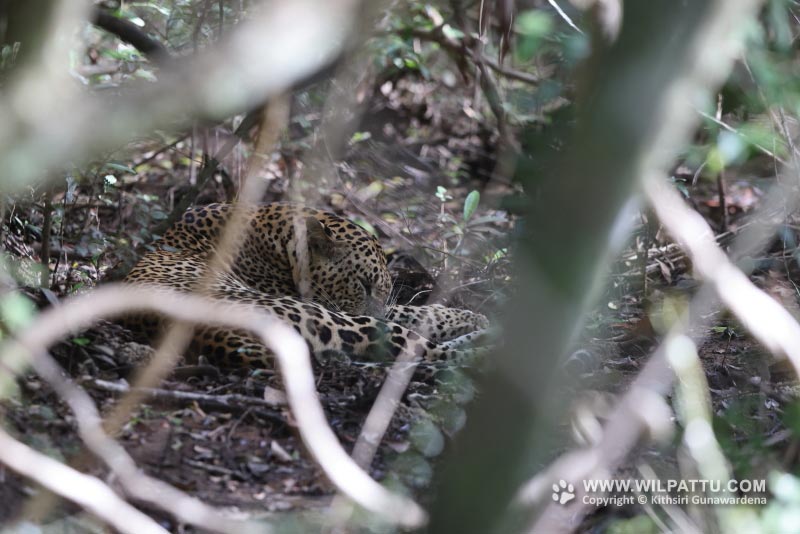
-
18th December 2021 at 9.25am one Leopard at Kumbuk Wila upper road. N 08.41565, E 079.99873
The safari jeep drivers told me that a leopard had walked along the road and moved into the forest few minutes ago. It was a big male and was sleeping at the foot of a tree. He was partly visible through the foliage from one spot on the road. After some time, the leopard was alerted by a sound of an animal moving through the forest and lifted its head briefly but was not interested to pursue and went back to sleep again. Prior to keeping his head down, he looked in our direction permitting me to get a few images. It was Nelum Wila Male 5 (NWMC 5), the dominant male in this area. As there were other safari jeeps that arrived, I moved out to give way for them to see the leopard.
-
23rd October 2021 at 5.02pm one leopard at Kudapatessa. N 08.43115, E 079.99353
We were informed of a leopard sighting at this location in the morning and around 1pm by a few jeep drivers. Around 4.45pm I was parked at Kudapatessa and noted the continuous alarm calls of an Indian Palm Squirrel. As there was no leopard in sight, we left to check out Kuruttupandi but returned to Kudapatessa and spotted a Leopard lying down on the sand patch across the villu. It was big male leopard. In a few minutes he walked across the sand patch back to the forest and started to
-
6th February 2021 at 9.10am one leopard at Eriyakkulampooval. N 08.43725, E 080.00208
The leopard was lying across the water body on the sandy area between the forest and the water edge. It was a big male leopard. I managed to get a few record images despite the distance. Within a few minutes he stood up walked into the forest. Later an examination of its spot pattern revealed that it is Nelum Wila Male 5 (NWMC 5).


-
18th July 2020 at 4.46pm one Leopard at Kuruttupandi Villu. N 08.43839, E 079.98236
As drove down to Kuruttupandi to see the leopard move in to the forest at the far left hand side. As we had received information of a “kill” and that a large male leopard was seen at this location the previous day and today morning we decided to wait expecting the animal to move out again. Fortunately for me the leopard climbed on to the lower branch of a Madan Tree and slept allowing me to get a few record images. Its bloated belly indicated that the cat had fed well. It was Nelum Wila Male 5 (NWMC 5). (with guide Lahiru Dissanayake)
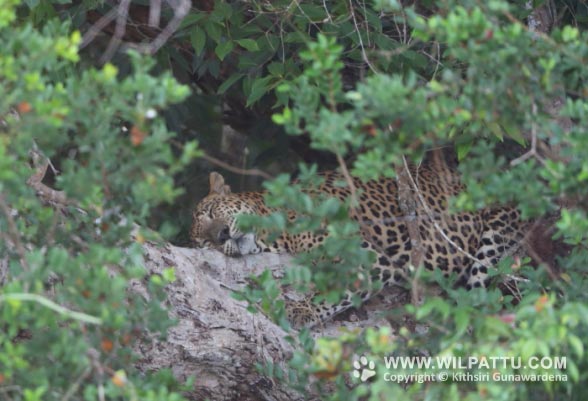
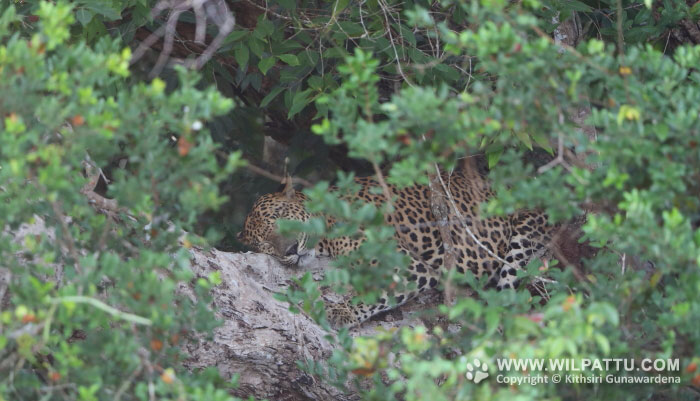
-
20th June 2020 at 1.46pm a Leopard on Kokkare Villu upper road. N 08.41198, E 079.98727
The Leopard was lying on the edge of the road but moved a short distance in to the forest as we arrived. I was pleased to note that this is Nelum Wila Male 5 (NWMC 5). Despite its young age (3 years and 5 months) he has grown in to becoming a large bodied impressive male. He was lying at the foot of a tree but I was able to get a few images adequate enough to identify the animal. A few more jeeps arrived and I left giving way for them to observe the animal. ( with safari jeep driver Gayan)
-
2nd February 2020 at 7.35am a male and a female leopard at Kudapatessa. N 08.43129, E 079.99345
I was informed of a mating pair of Leopards seen the previous day evening at Kuruttupandi Villu. Thus, I arrived at the park entrance at 2.30am to ensure that I will be the first vehicle to enter the park. We drove down to Kuruttupandi Villu and had no luck but arrived at Kudapataess to spot the two leopards in the nick of time before they moved into the forest. The male and the female exhibited typical leopard mating behavior but did not mate. They walked together in the direction of the sand dune across the villu but thankfully the female stopped and laid down resulting in the male to stop as well. After a few minutes the male resumed the walk followed by the female. Both the leopards walked over the sand dune into the forest. The male was the Nelum Wila Mlae 5 (NWMC 5) and the female was Manikrala Uraniya Female 1 (MRUF 1). I received images of these two leopards mating on the 14th of February in 2019 and thereafter again on the 12th of June the same year. However, this female is yet to conceive. (With guide Hashan Madushanka)
12th January 2020 at 7.50am a leopard was observed on Kumbuk Wila upper road. N 08.41848, E080.00203
The leopard was lying down on a small patch of sand about 20 feet from the road. It was a male and he walked in to the forest almost as we arrived. I managed to get a few images in the nick of time to identify the animal. It was Nelum Wila Male 5 (NWMC 5). (with guide Tissa Ratnayake)
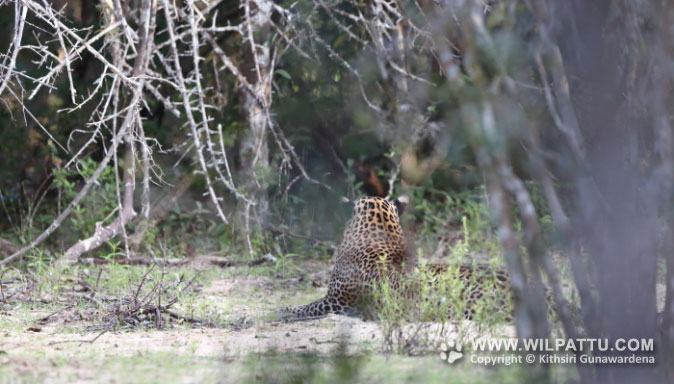
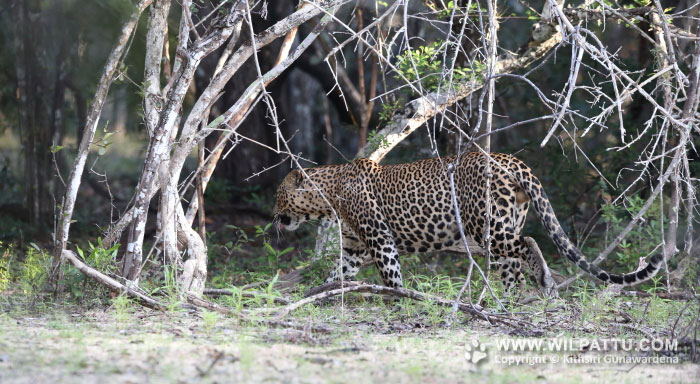
-
15th December 2019 at 1.15pm another Leopard at Illanda Motte. N 08.45878, E 079.98997
Having stopped at Manik Wila to study the spot pattern of the Leopard photographed at Kurruttupandi we preceded to Ilanda Mote and were pleasantly surprised to see a male Leopard marking the bushes along the Ilanda Motte bund road. He disturbed a small gathering of Lesser Albatross butterflies that were “mud sipping” on the road and walked in the direction of Down Hall Pitiya. Thankfully the majestic animal turned back to look in our direction permitting us to get few images prior to continuing his walk. Having walked almost up to the large pool of water on the road the leopard turned back and walked in to the forest. Upon examining the spot pattern I was happy to note that this is Nelum Wila Male 5 (NWMC 5), the Leopard that we photographed at the Kokkare Villu sand dune the previous evening. Even though this animal is still around three years in age he is quite well built. The distance between the two GPS points from Kokkare Villu sand dune to Illanda Motte is 3.96 kilometers. (with guide Tissa Ratnayake)
-
14th December 2019 at 2.44pm one Leopard at Kokkare Villu sand dune. N 08.42323, E 079.98573
We drove down to the “weli Katte” from Kokkare Villu to be greeted by a frantic Spotted Deer that dashed through the bushes while making its high pitched alarm call. Indian Palm Squirrels and White-browed bulbuls started making alarm calls. We searched carefully and managed to spot the Leopard seated on its hunches. The view was partly covered by foliage but I managed to get a few images. The cat lied down and was soon fast a sleep with its eyes tightly closed. Upon enlarging the images I realized that this is Nelum Wila Male 5 (NWMC 5). There after we proceeded on to the “one way” road to Kudapatessa from where we managed to get a good view of the sleeping cat. While we were observing a male Indian Peafowl walked passed the sleeping Leopard. Even though Leopards often kill Peafowl this bird did not show any apprehension of the sleeping cat. Perhaps the bird knew that the sleeping cat posed no danger.
After some time the Leopard stood up and walked to the edge of the forest and lied down again. Around 4.24pm with few other vehicles arriving at the spot we moved off permitting them to observe and get some images of this fine specimen. (with guide Tissa Ratnayake)
-
16th August 2019 at 10.20am one Leopard on Kokkare Villu upper road. N 08.42269, E 079.98274
The Leopard was lying behind a bush and was only visible from one point on the road. I was not able to get any clear images. Having taken a few images I moved off permitting visitors of vehicles also to have a view of the animal. Later upon studying the spot pattern I identified the Leopard as Nelum Wila Male 5 (NWMC 5). (with guide Tissa Ratnayake)
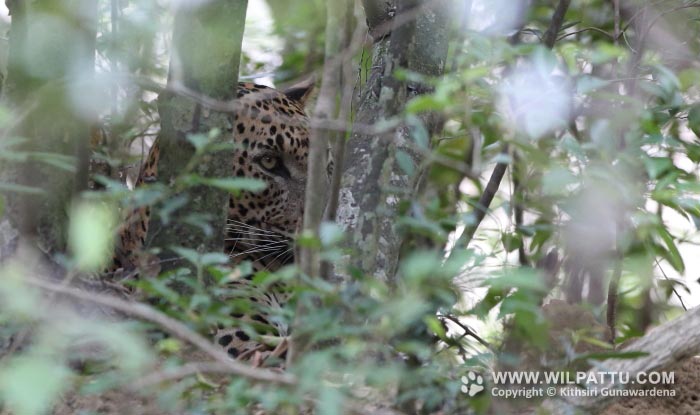
-
9th June 2019 at 7.37am one Leopard at Kudapatessa junction. N 08.43251, E 079.98267
We arrived at the Kudapatessa junction and spotted the Leopard walking down from Kudapatessa. He stopped close to us and started making the “sawing” call. There after he moved in the direction of Kuruttupandi Villu. I permitted the Leopard to move about 30 meters and started to follow. He was disturbed by a troop of Grey Langur that started to make alarm calls and lied down on the road and started to “saw” again. The Leopard was Nelum Wila Male 5 (NWMC 5) who is know approximately 3 years and 5 months old. Leopards make these “sawing” calls to pronounce their presence to other males as well as to find females. In a few minutes with the intensity of the Langur’s alarm calls rising the Leopard walked in to the forest followed the Grey Langur troop in the trees barking alarm calls. (with guide Tissa Ratnayake)
-
19th November 2018 at 11.48am one Leopard at Kumbuk Wila. N 08.42204, E 080.00693
I stopped at Kumbuk Wila “summer hut” briefly and learnt from the jeep drivers that there had been no leopard sightings till then. We advanced about 100 meters in the direction of Borupan junction and I was alerted by the alarm call of an Indian Palm Squirrel. Having examined the foliage my guide Tissa spotted a Leopard lying down on a small mound of earth partly covered by foliage less than 10 feet from the edge of the road. I managed to get a few record images to identify the leopard. It was Nelum Wila Male 5 (NWMC 5). In a few minutes the young leopard stood up and walked in to the jungle. (with guide Tissa Ratnayake)

-
18th November 2018 at 7.54am one Leopard at Lunuwew road junction. N 08.42844, E 080.02660
We drove from Borupan Wila on to the Lunuwewa road and spotted a Leopard at the junction. I reversed the vehicle as I was too close to the leopard and was keen to give it adequate space. The Leopard, after sniffing the decaying tree at the junction, started to walk in the direction of Lunu Wewa. I followed the animal maintaining a distance of about 30 meters. He marked the bushes and turned and looked in our direction permitting me to take a few images. It was Nelum Wila Male 5 (NWMC 5). The young male was in excellent condition. I was so thrilled to see this male that had eluded me during my past few trips. Having walked about 40 meters the Leopard moved in to the forest. (with guide Tissa Ratnayake)
-
17th November 2018 at 2.06pm two leopards on Kumbuk Wila upper road. N 08.41837, E 080.00825
It was Nelum Wila Male 5 (NWMC 5) and Kumbuk Wila Female 2 (KWFC 2). As we approached the bent Ficus Tree on this road saw a male leopard crossing the road. I was not able to get any images of this animal as he moved in to the forest towards Kumbuk Wila. After a few minutes a female leopard emerged from where the male leopard moved on to the road. She walked for a few meters in our direction and moved in to the forest following the male. I was able to get a few good images of this animal and identified her as KWFC 2. Upon examining photos taken by another visitor I was able to confirm that the male was NWMC 5. (with guide Tissa Ratnayake)
-
27th May 2018 at 3.55pm one Leopard on Kumbuk Wila upper road. N 08.41808, E 080.00737
It was Nelum Wila Male 5 (NWMC 5). It was a very brief sighting. The young Leopard was disturbed by the number of vehicles that had gathered at this spot and retreated in to the forest. ( with Guide Tissa Rtnayake)
-
27th May 2018 at 12.47pm before driving to the bungalow for lunch I decided to drive down to Madangaha Wala to record the GPS reading of the former leopard sighting. While checking the reading we heard the low growl of a leopard and decided park at bordering the open glade.
1.04pm Two Leopards at Madangaha Wala. N 08.41539, E 079.99796
A female Leopard emerged from the thicket followed by another male. Later upon checking their spot patterns I was able to ID them as Nelum Wila Female 3 (NWFC 3) and Nelum Wila Male 5 (NWMC 5). It was wonderful to see these youngster siblings chasing each other and play fighting like a pair of domestic cats. We watched them for about 10 minutes and left to proceed to the bungalow. ( with Guide Tissa Rtnayake)
-
27th May 2018 at 8.18am one Leopard at Madangaha Wala. N 08.41572, E079.99854
Having heard that two leopards had crossed the main road we arrived at Madangaha Wala. There were two vehicles parked in expectation of the leopards. I decided to park away from the parked vehicles expecting the leopards to cross the road towards Nelum Wila from the forested area of the road. One leopard emerged from the thicket and I managed to get a few images. I was able to instantly recognize that this is Nelum Wila Male Cub 5 (NWMC 5). He was bold enough to cross the road in between the vehicles and disappear in to the forest. ( with Guide Tissa Rtnayake)

-
26th May 2018 at 4.08pm one Leopard on Kumbuk Wila upper road. N 08.41812, E 080.00120
Upon checking the spot patterns images I was able to conform that it is Nelum Wila Male Cub 5 (NWMC 5). The young male leopard was by the side of the road and walked across the road. Having sniffed the ground he defecated and walked on to the road and started to walk away from the vehicle. After a few minutes he lay down and rested on the road. I managed to get a few images and allowed the vehicle following me to move ahead for a better view. Upon another vehicle arriving from the opposite direction the leopard moved in to the forest. (with Guide Tissa Ratnayake)
-
4th February 2018 at 11.51am one Leopard between Kokkare Villu junction and Nelum Wila. N 08.40936, E 079.98470
It was Kumbuk Wila upper road Leopard 1 listed under Leopards of Wilpattu – Guest section. This is my first sighting of this young male leopard. I estimated its age to be around 2 years. He was lying on the ground about 15 feet from the road. After about 10 minutes, with the build up of vehicles, he stood up and walked further in to the forest and lay on the floor again. Having slept for about an hour he was alerted by an alarm call of an Indian Palm Squirrel and walked on to the road, sat on its hunches and walked across to the opposite side. I named this leopard Nelum Wila Male 5 (NWMC 5) ( with guide Tissa Ratnayake)
